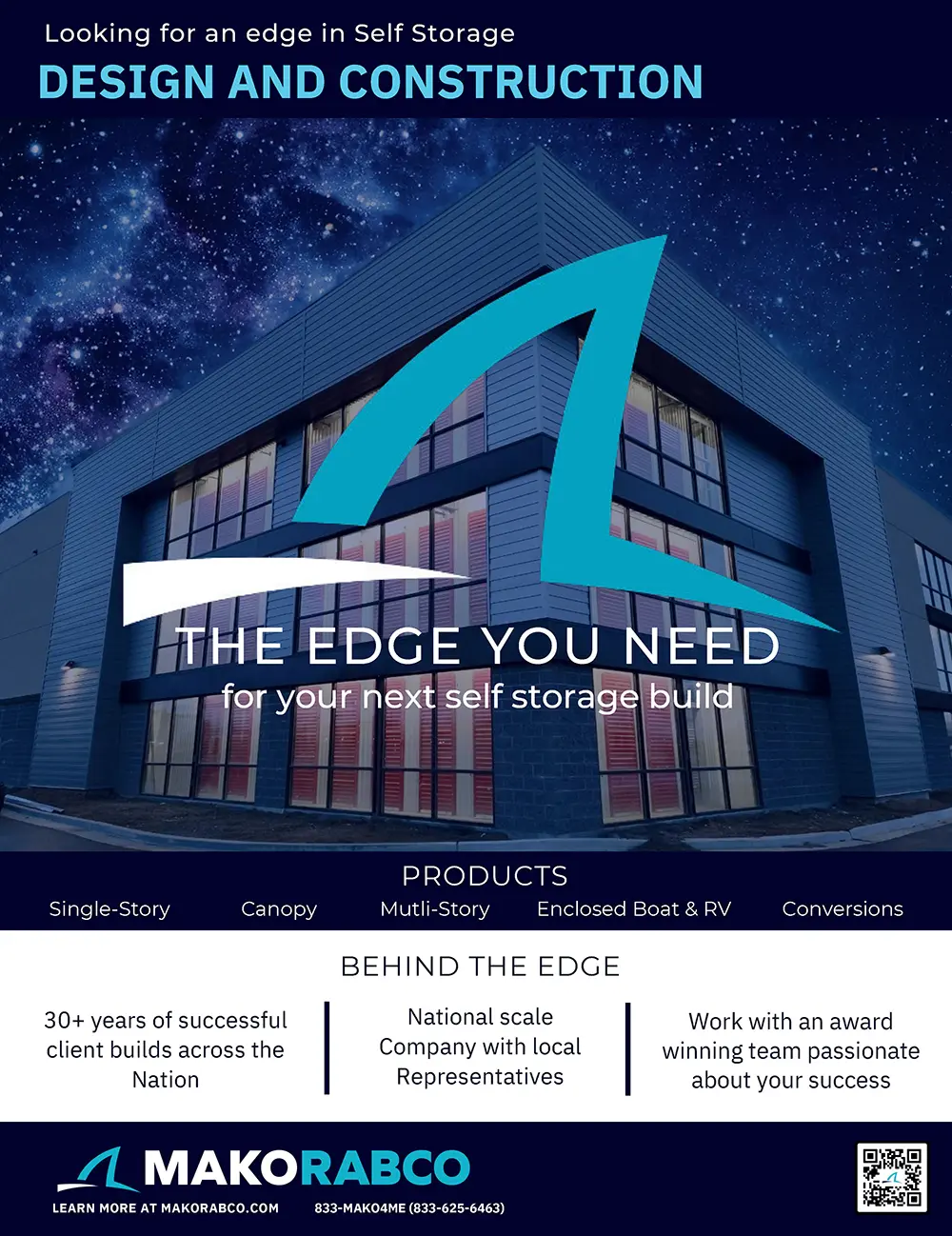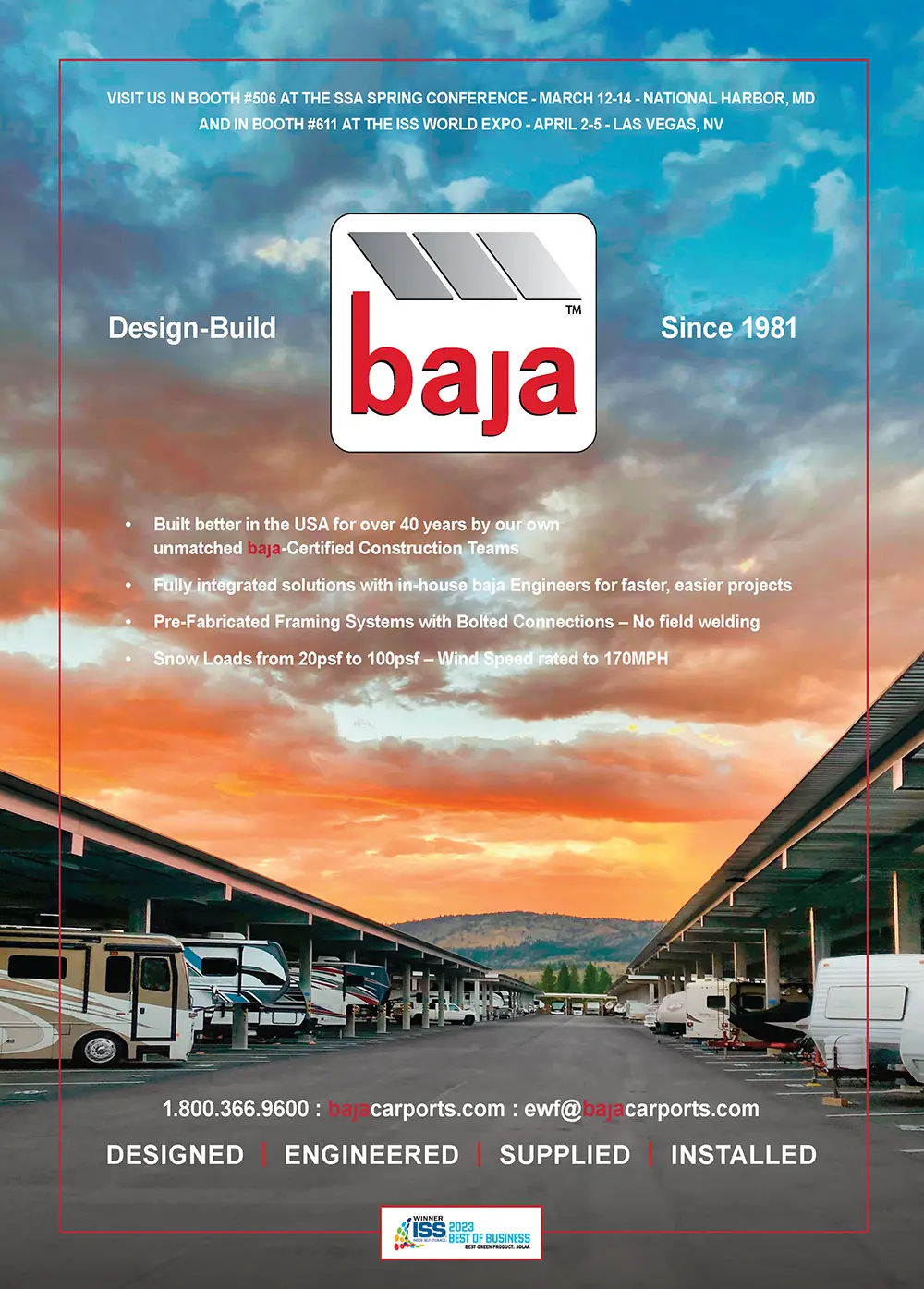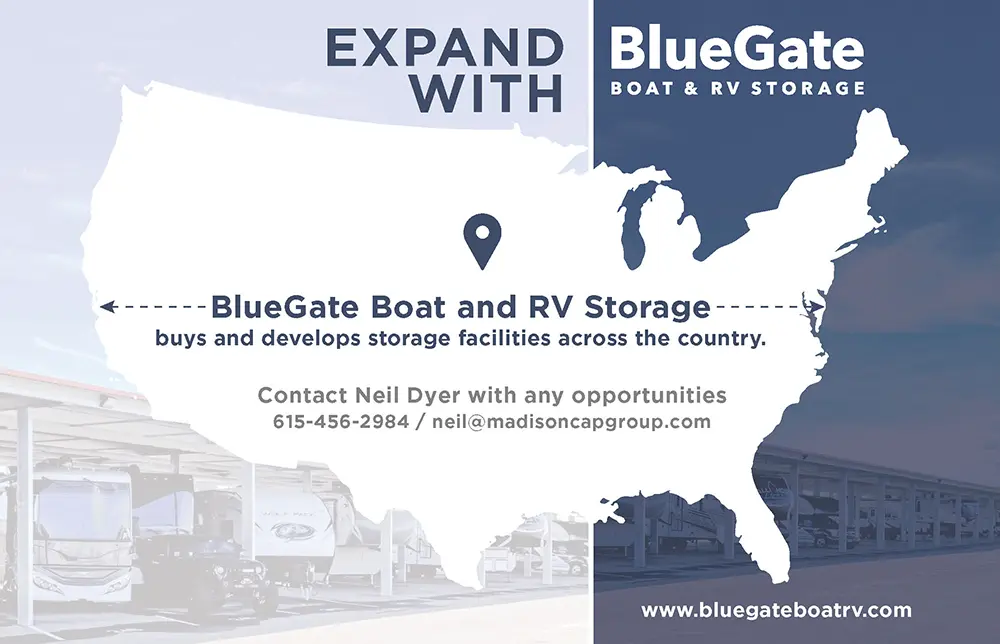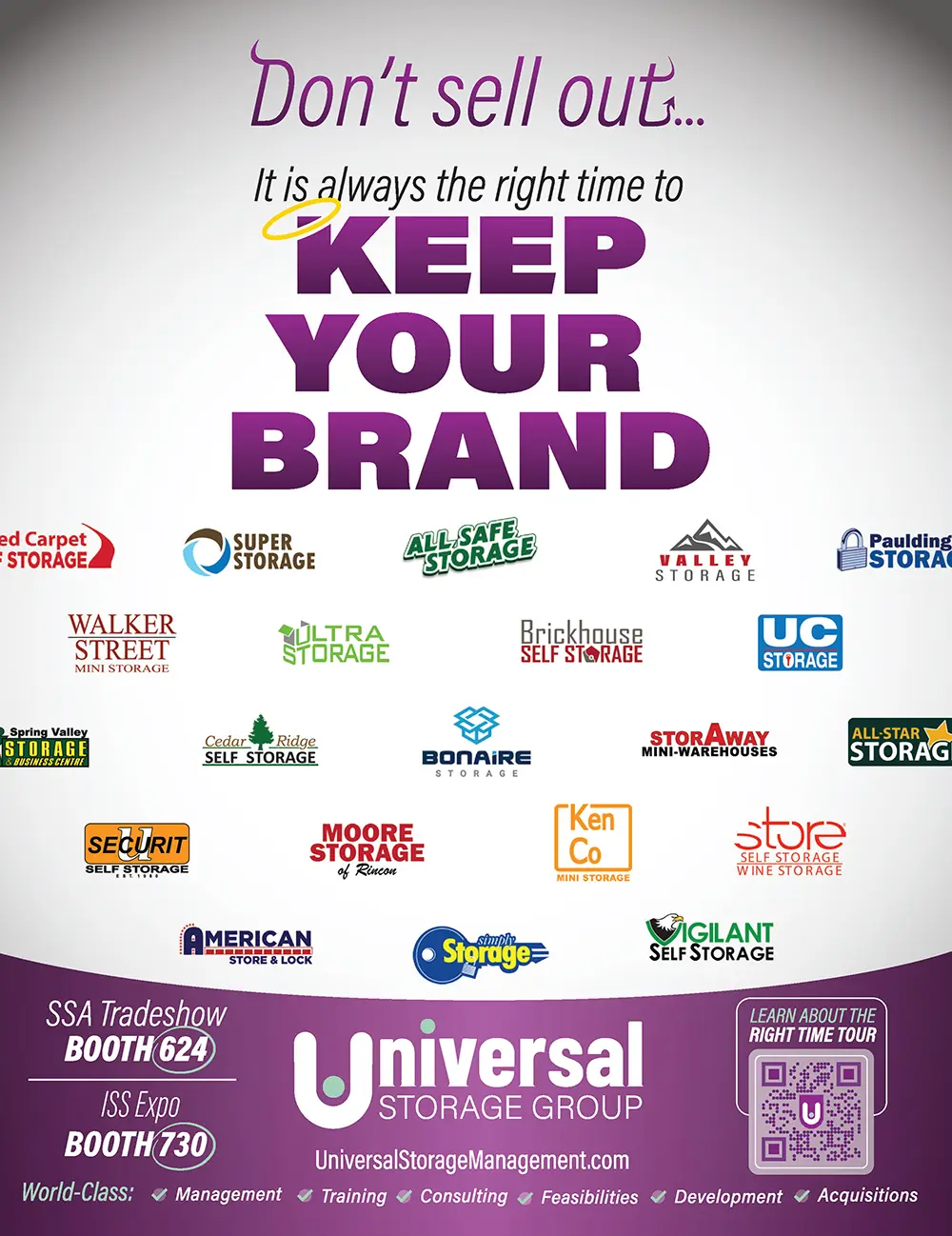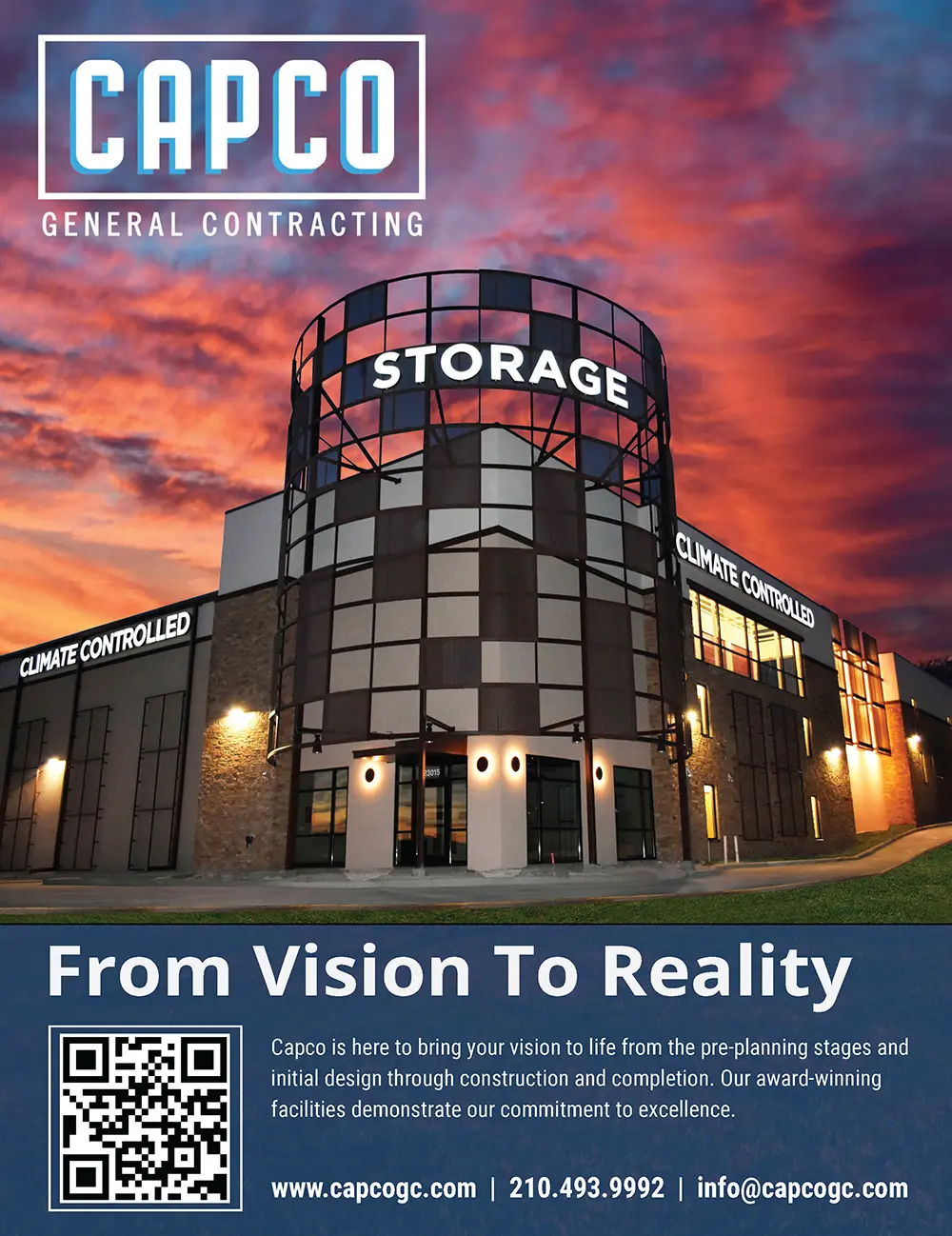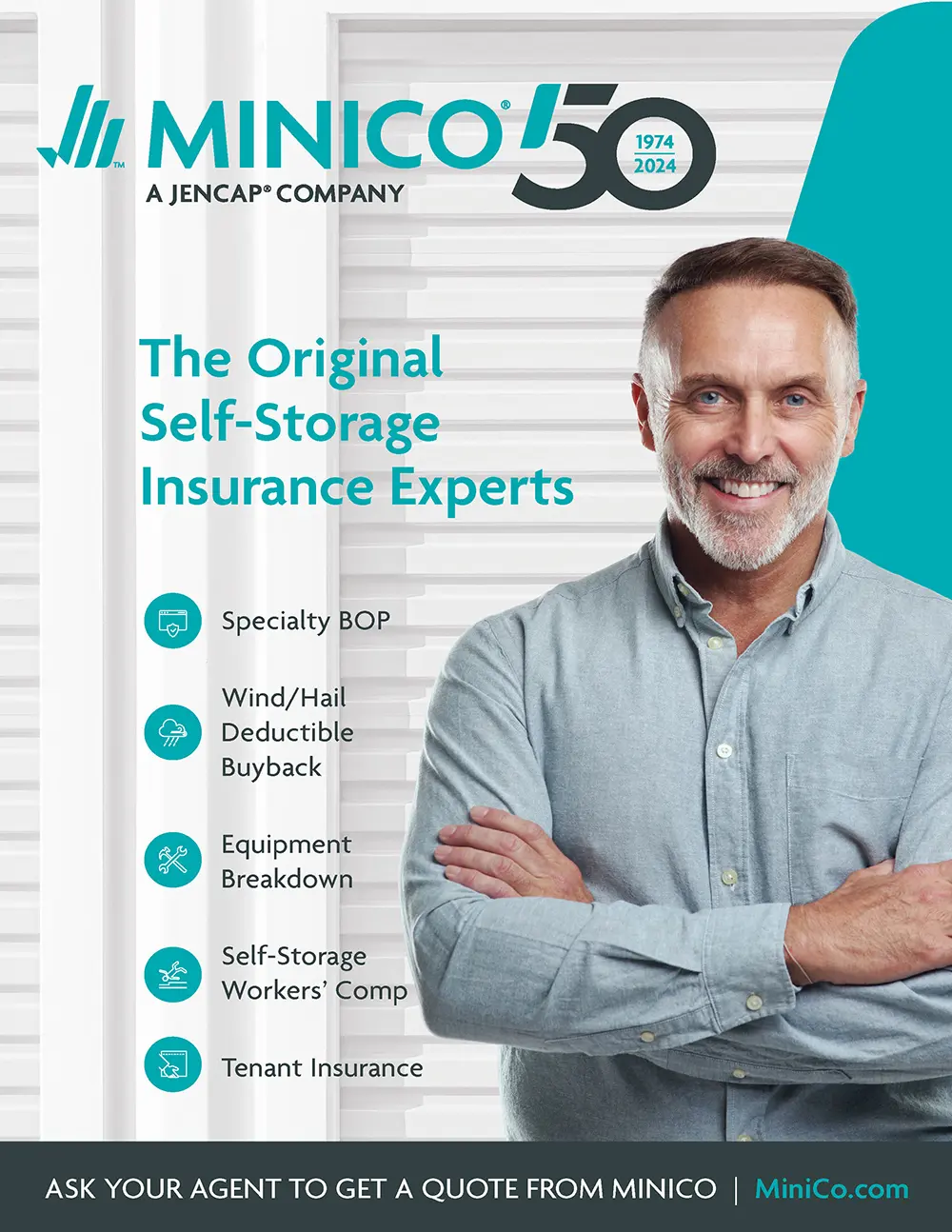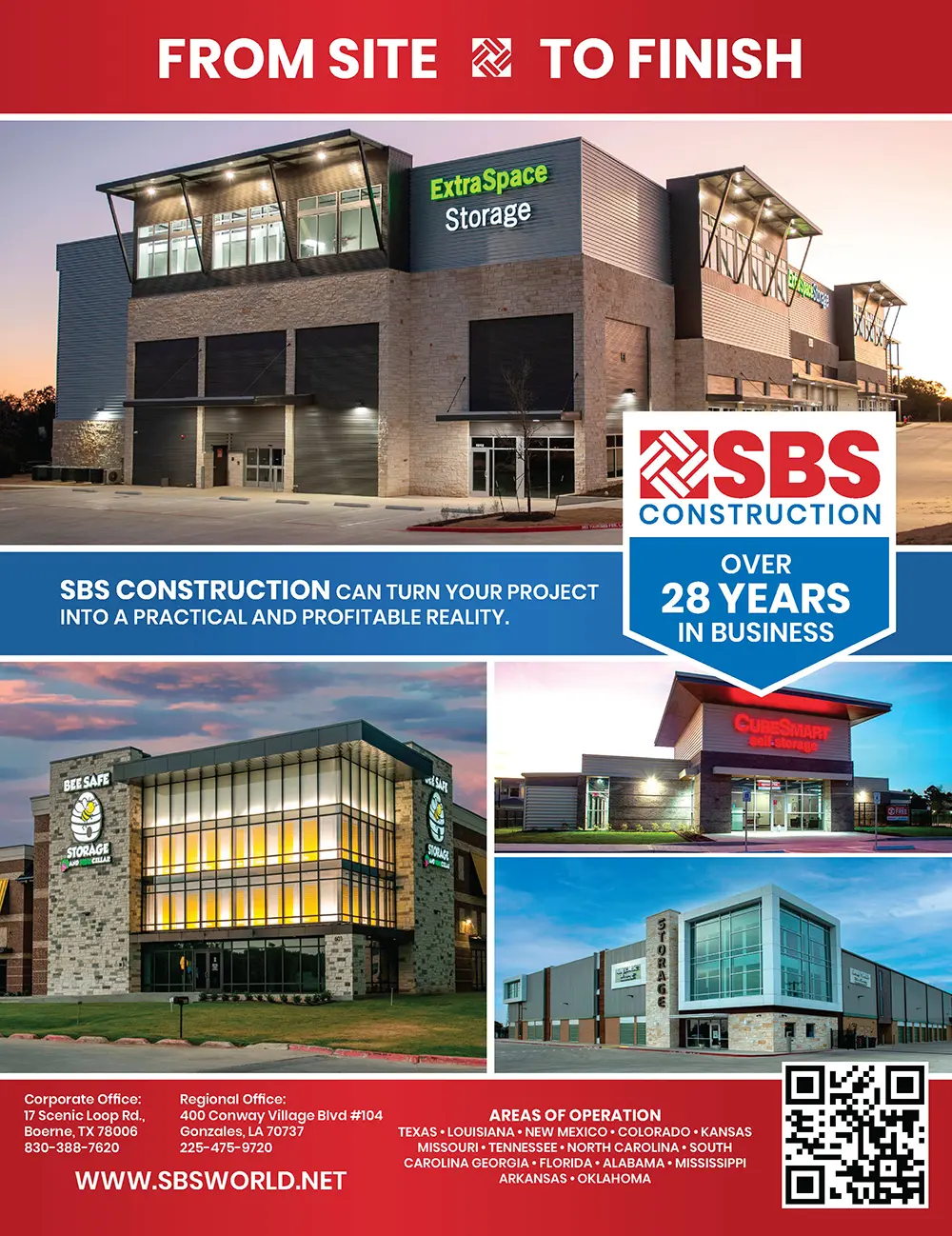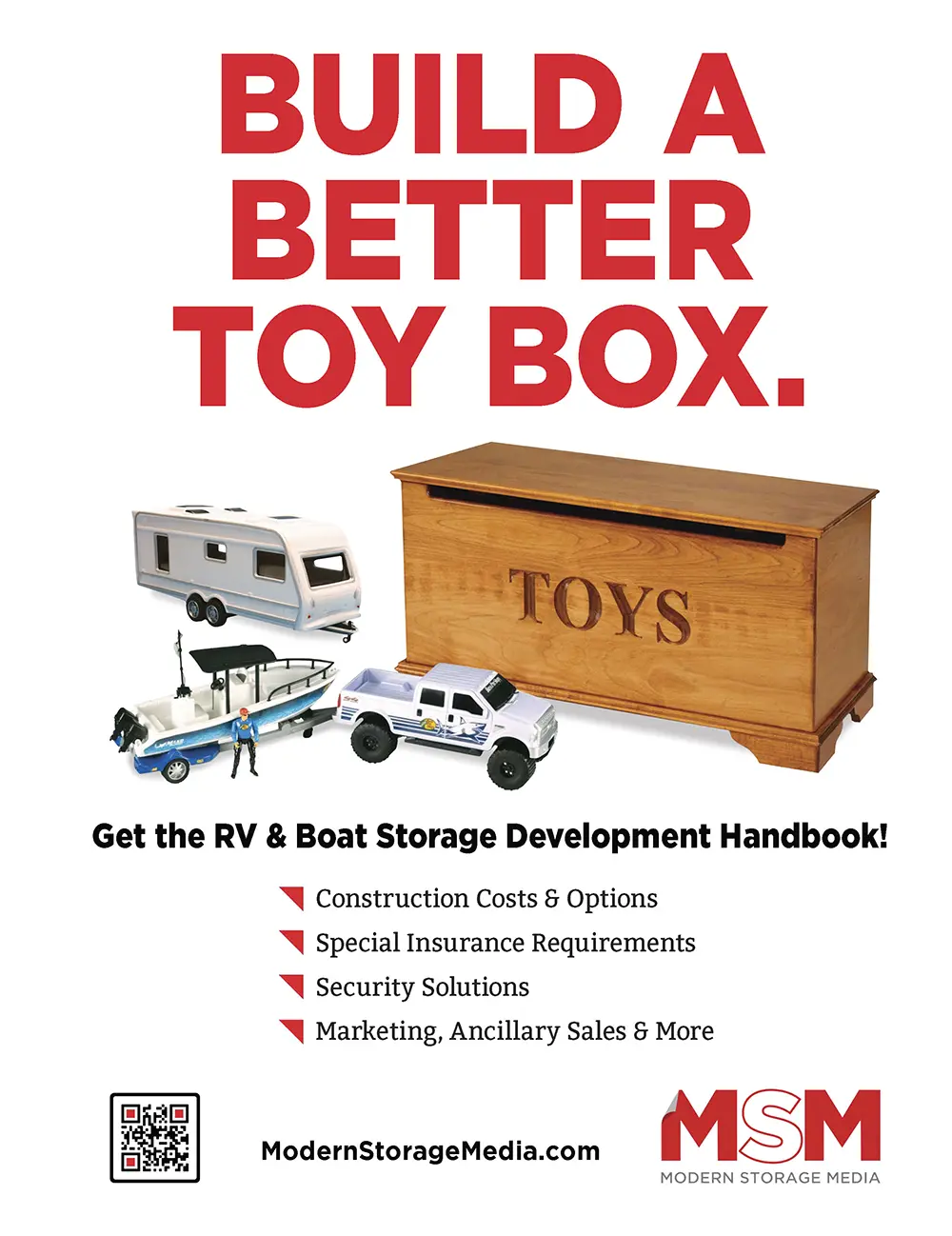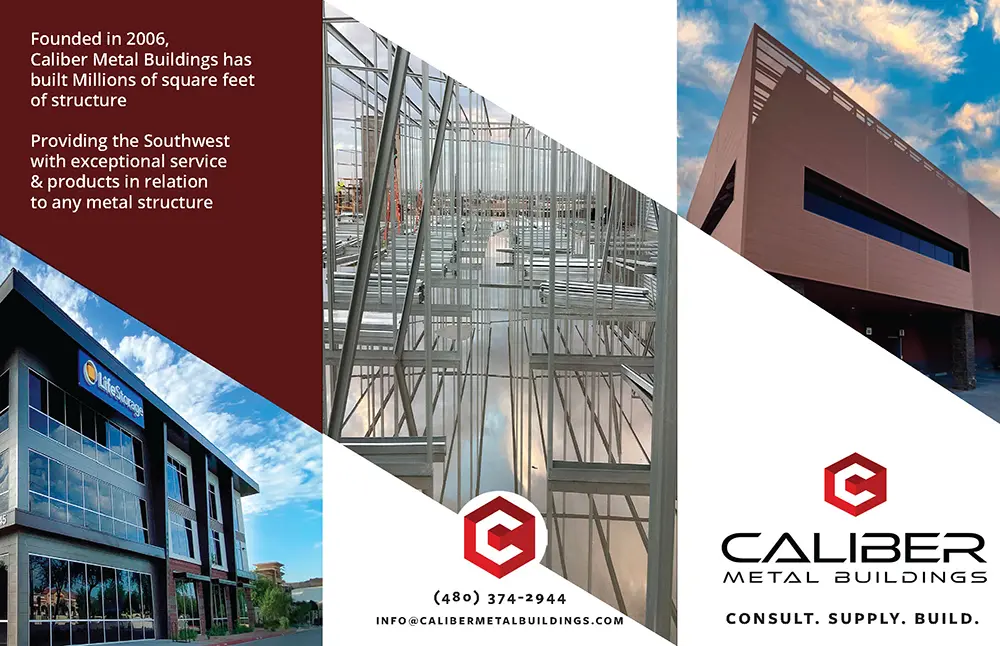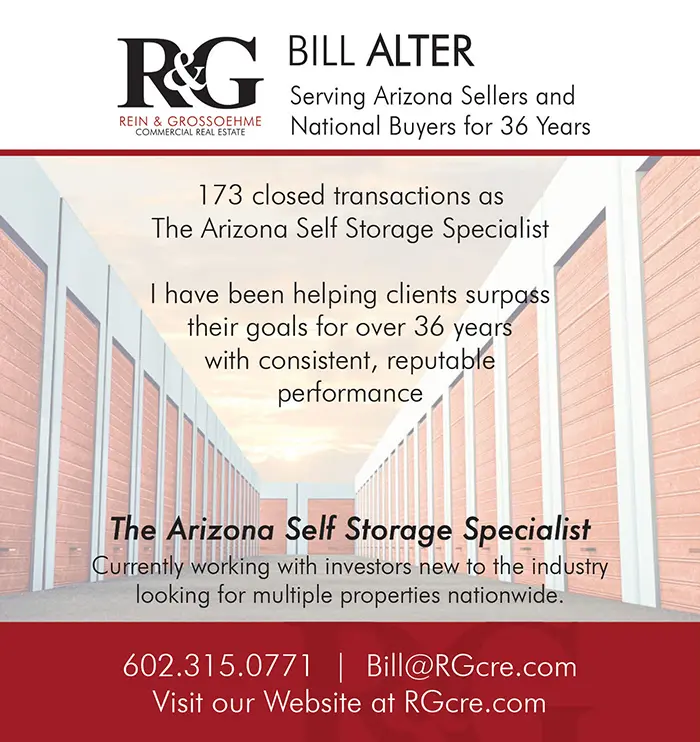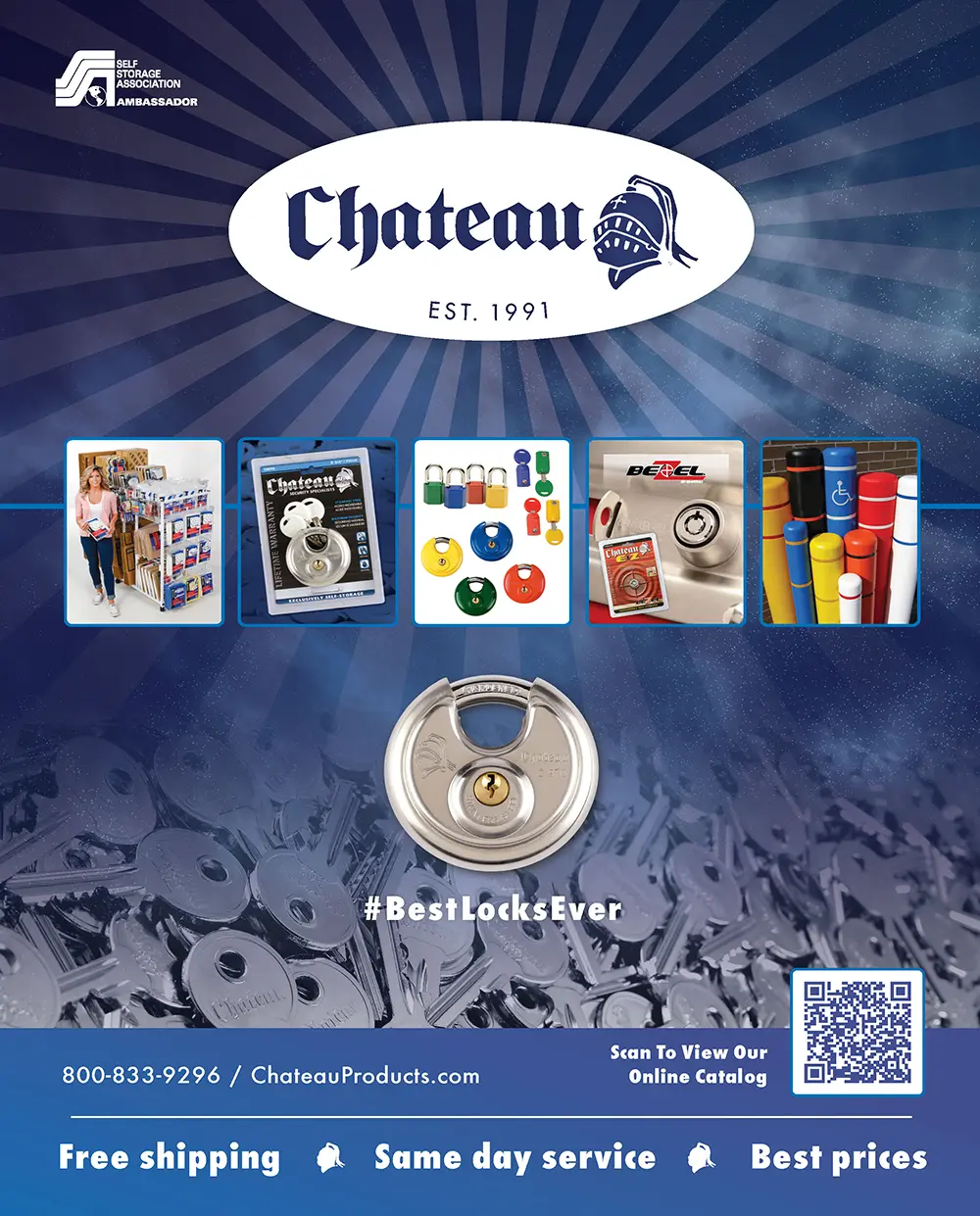How to enjoy our new magazine:
Just scroll!
Click or tap the table of contents icon in the menu bar to find any article.
Read any article by clicking or tapping the read full article button below each article intro.
Jump back to your previous browsing spot from any article using the menu bar or back to issue button.

RENOVATING OLD, IT’S AS EASY AS
For over 20 years, Janus International has led the way with turn-key self-storage building solutions, from premium roll-up and swing doors to state of the art security technology and facility automation tools.


-
Unlocking The Power Of Organizational CulturePage 14
-
Abandoned Property In Self-StoragePage 18
-
Six Questions To Help You DecidePage 20
-
The Importance Of Regular Lease AuditsPage 22
-
Innovations And Technologies Transforming The IndustryPage 24
-
Army Discontinues Free Storage ProgramPage 28
-
Embracing AI To Propel Your Business Into The FuturePage 32
-
Bringing Boat Owners To Your FacilityPage 72
-
Six Tips To Balance Functionality, Aesthetics, And CostsPage 76
-
The Rise Of Vertical Solutions In Urban Self-StoragePage 78
-
StorBox Self Storage in Pasadena, Calif.Page 82
-
Navigating Lending In 2024Page 86
-
Is Your Website Working For You?Page 90
-
Effectively Using Digital Marketing To Promote Your PropertyPage 94
- Chief Executive Opinion by Travis Morrow 6
- Publisher’s Letter by Poppy Behrens 9
- Meet The Team 10
- Women In Self-Storage: Ginny Stengel by Erica Shatzer 37
- Who’s Who In Self-Storage: Ramey Jackson by Erica Shatzer 41
- StorageGives 101
- Self Storage Association Update 103
- The Last Word: Drew Hoeven 104
For the latest industry news, visit our new website, ModernStorageMedia.com.

/’klīmət/
the weather conditions prevailing in an area in general or over a long period.
You can control the temperature, you can control the humidity, but you can’t control the weather. Weird we chose that adjective.

He’s also the president of National Self Storage.

-
PUBLISHER
Poppy Behrens
-
Creative Director
Jim Nissen
-
Director Of Sales & Marketing
Lauri Longstrom-Henderson
(800) 824-6864 -
Circulation & Marketing Coordinator
Carlos “Los” Padilla
(800) 352-4636 -
Editor
Erica Shatzer
-
Web Manager / News Writer
Brad Hadfield
-
Storelocal® Media Corporation
Travis M. Morrow, CEO
-
MODERN STORAGE MEDIA
Jeffry Pettingill, Creative Director
-
Websites
-
Visit Messenger Online!
Visit our Self-Storage Resource Center online at
www.ModernStorageMedia.com
where you can research archived articles, sign up for a subscription, submit a change of address. 
- All correspondence and inquiries should be addressed to:
Modern Storage Media
PO Box 608
Wittmann, AZ 85361-9997
Phone: (800) 352-4636



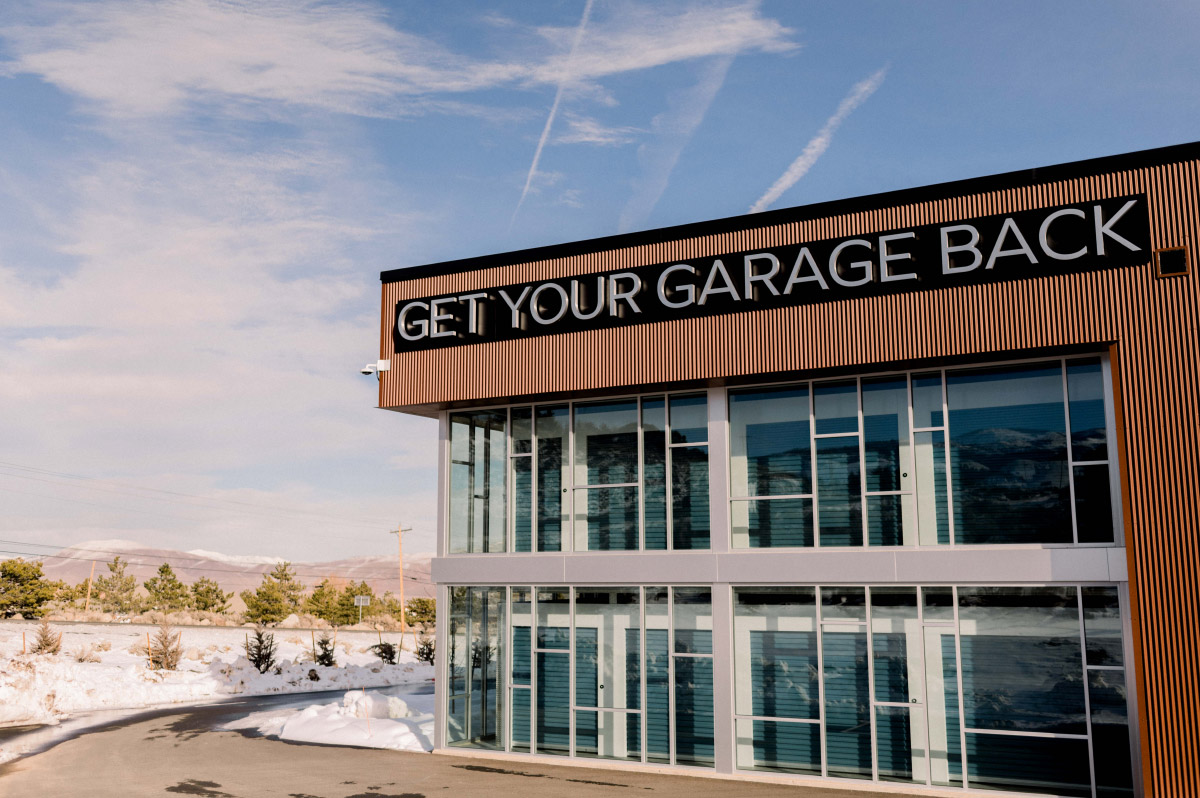
theparhamgroup.com
ata: Everyone wants it … everyone needs it … but why?
Simply stated, access to the right data drives decision-making and overall growth for businesses across the board. It provides the information needed to answer questions, analyze business performance, and predict future trends, actions, and scenarios. Nowhere is this more important than in the self-storage industry.
For nearly 40 years, it has been our goal to provide the best data available to the self-storage industry. From the annual Self-Storage Almanac and Expense Guidebook to our Development Handbook series and educational articles, MSM provides you with the data you need. Whether you are developing a self-storage facility for the first time, expanding an existing facility, or looking to grow your self-storage portfolio, these resources will help you find the answers you need. As such, we proudly announce that both the 2024 Self-Storage Almanac and Expense Guidebook are now available.
This newest edition of the Almanac features the most up-to-date data, trends, and analysis that self-storage owners, operators, investors, developers, and appraisers have come to rely on. Available as a stand-alone product or as a part of the 2024 Appraisal Bundle, the 2024 Expense Guidebook offers overall expense-to-income ratio on a national basis, as well as overall facility income and rental revenue growth and the traditional expense data broken down into more precise categories.
For more information about ordering the Self-Storage Almanac or the Development Handbook, please call (800) 352-4636 or visit www.modernstoragemedia.com, where you can order any of the amazing educational products we offer.
Remember: Data and due diligence go hand in hand. MSM offers the products you need to make your self-storage journey a success!

Publisher

MSM’s data-derived products have the content you need to reach your self-storage goals!
ata: Everyone wants it … everyone needs it … but why?
Simply stated, access to the right data drives decision-making and overall growth for businesses across the board. It provides the information needed to answer questions, analyze business performance, and predict future trends, actions, and scenarios. Nowhere is this more important than in the self-storage industry.
For nearly 40 years, it has been our goal to provide the best data available to the self-storage industry. From the annual Self-Storage Almanac and Expense Guidebook to our Development Handbook series and educational articles, MSM provides you with the data you need. Whether you are developing a self-storage facility for the first time, expanding an existing facility, or looking to grow your self-storage portfolio, these resources will help you find the answers you need. As such, we proudly announce that both the 2024 Self-Storage Almanac and Expense Guidebook are now available.

MSM’s data-derived products have the content you need to reach your self-storage goals!
For more information about ordering the Self-Storage Almanac or the Development Handbook, please call (800) 352-4636 or visit www.modernstoragemedia.com, where you can order any of the amazing educational products we offer.
Remember: Data and due diligence go hand in hand. MSM offers the products you need to make your self-storage journey a success!

Publisher
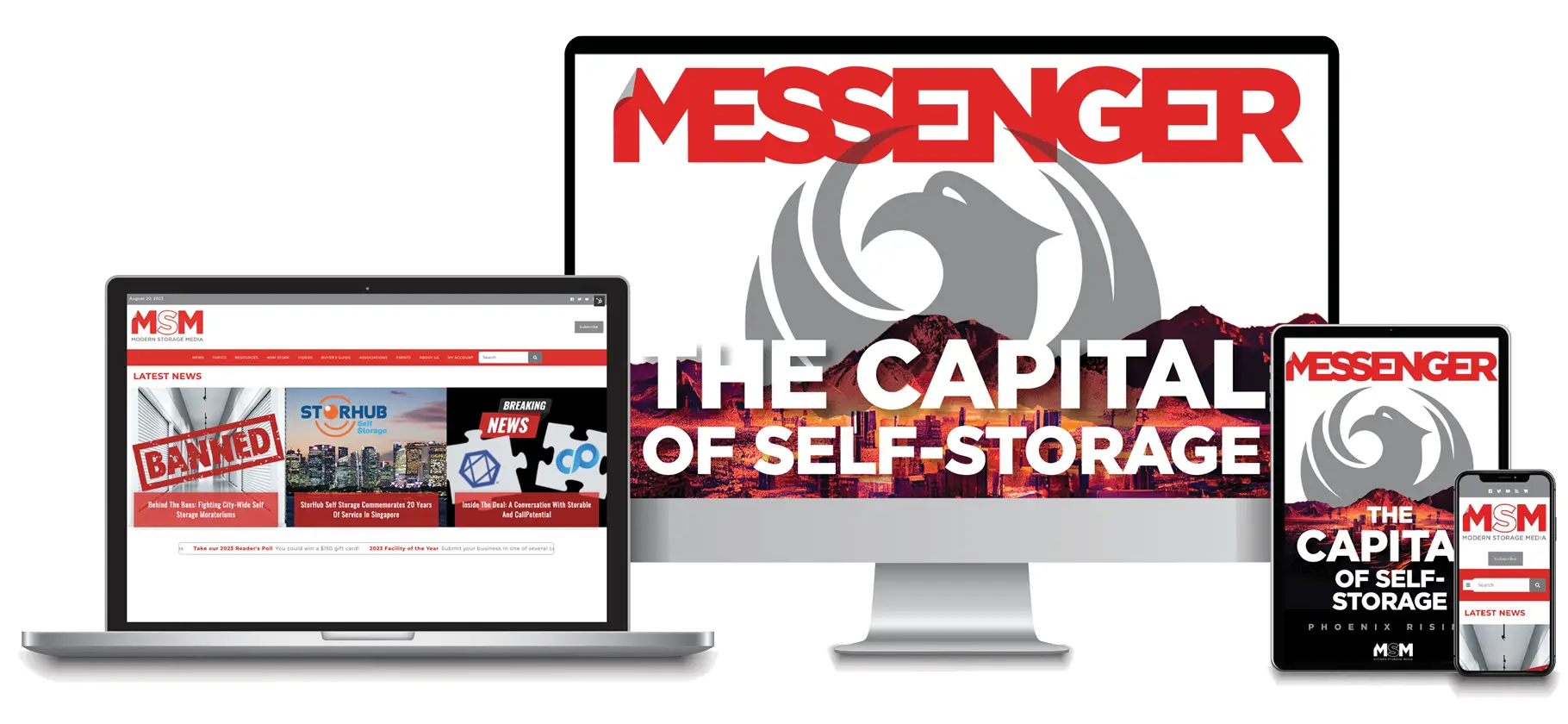
- Breaking news updated daily
- Real-time sales and acquisitions updates
- A newly redesigned calendar of events
- Enhanced promotional opportunities for advertisers
The website also enables readers to submit news, events, and article ideas. Don’t forget to browse the MSM Store for dozens of exclusive, storage-specific publications, including three of the industry’s most trusted resources: the annual Self-Storage Almanac, The RV & Boat Development Handbook, and the annual Expense Guidebook. New publications are frequently added to its extensive list of offerings!




Modern Storage Media



Messenger







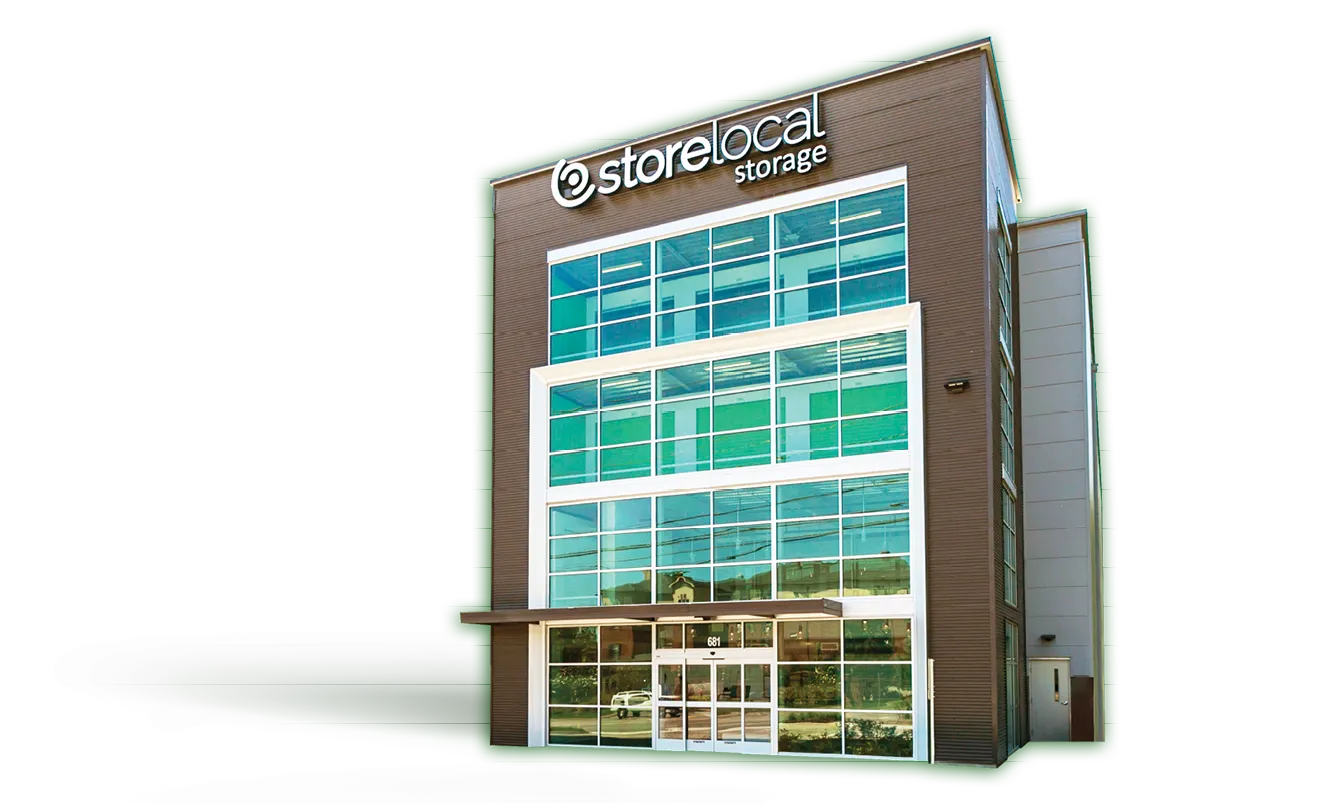

ealing with troubling workplace environments can be difficult. The deeper issue is not always clear, and the friction and conflict it breeds can be tough to reverse.
At the heart of any organization are its people. Without a dedicated, aligned, and fully engaged workforce, no progress can be made. High-performance organizations excel in creating an environment that recognizes and addresses the fundamental human needs that drive their members.
Establishing effective lines of communication between employees and their superiors is a great way to create certainty. When integrating new hires, make sure they have clarity on their role and their responsibilities. Encourage them to ask questions. For existing employees, having occasional check-ins ensures they are aligned with their jobs and not struggling to fulfill their physiological needs or produce at work.
Boundaries need to also be respected. Treating people how they want to be treated goes a long way toward making them feel safe in their environment. An organization that provides safety for its employees earns trust, thus possessing a foundational element of a healthy, high-performance culture.
Everyone has a need to belong and be accepted for who they are. Understanding the motives of new hires for joining the organization and what they believe they will gain from their work can aid in fostering a sense of belonging.
Organizations can further support this need by asking existing employees various questions and attempting to better understand each individual. Some questions to ask include:
- Are they happy in their role and doing their work? Is it aligned with what’s important?
- How do they feel they are contributing through their work?
- What matters to them? What causes do they care about?
- What do they want to be doing with their life?
- How can their job help them experience belonging?
Asking about their job satisfaction, contributions, and personal aspirations emphasizes the importance of each individual’s role in the organization’s success, cementing a feeling of belonging and increasing engagement and satisfaction.
According to Maslow, individuals must fulfill lower needs before pursuing higher ones. To reach self-actualization, every need in Maslow’s hierarchy must be addressed first. Because of this, Maslow asserts that less than 1 percent of the adult population ever achieves this level. Keep in mind that this was published over 50 years ago. In today’s world, psychologists think it is closer to 5 percent, solely because there is a deep desire in humans to contribute and feel a sense of fulfillment—the more people evolve, the more they want to experience these higher feelings of satisfaction in their work.
The fundamentals of an emergent culture are closely intertwined with the needs of individuals within the organization. Prioritizing the well-being and fulfillment of employees is key to catalyzing to Maslow’s top 1 percent, nurturing an emergent company culture that contributes to personal and organizational success and growth.
he question of “abandonment” of stored property is challenging in the self-storage industry. Tenants move in and out of their units on a daily basis. When moving out, some intentionally leave items behind (for example, the moving truck is too small), others leave items by mistake, and then there are others who, based on circumstances often out of their control, simply elect to forego all of their stored items because they simply can’t pay the outstanding rent needed to retrieve the property or the cost to remove them.
How does a self-storage operator determine whether the items left behind in a storage unit have been abandoned by their owner? Other than obtaining a written abandonment form, which is the best solution, what other tools can an operator use to verify that the property left in a space (whether it’s a full unit or a bag of old clothes) has been intentionally abandoned by the previous tenant?
An unlocked space by itself may not indicate a voluntary move-out, so property simply left in an unlocked space would not necessarily indicate abandonment. But add a rent default or pending lien action and the facts may indicate otherwise. Further, add a text or e-mail from the tenant about their intent to vacate and that might be sufficient. Communication is key. Before acting on any assumptions, an operator should communicate with the tenant, by letter, e-mail, text, or phone. Confirming a move-out is the simplest way to avoid an incorrect assumption about an abandonment.
Maine defines Abandonment as follows:
§1372. Definitions As used in this chapter, unless the context otherwise indicates, the following terms have the following meanings. [PL 1989, c. 62 (NEW).] 1. Default. “Default” means the failure to perform on time any obligation or duty set forth in the rental agreement. [PL 1989, c. 62 (NEW).] 1-A. Abandoned leased space. “Abandoned leased space” means a leased space that the operator finds unlocked and empty or unlocked and containing personal property with a value less than $750 or a leased space possession of and all rights to which and any personal property within which have been surrendered to the operator by the occupant.
Then the Statute provides direct guidance to the operator on their rights after the abandonment has been triggered:
§1378. Abandonment. In the case of an abandoned leased space, the operator has the right to immediately take possession of the leased space and dispose of any personal property in the leased space by any means at the operator’s discretion.
It would be very helpful if more states followed this process in their laws.
At the end of the day, if the pieces of the puzzle on abandonment are not clear, an operator always has the right to simply wait to allow the lien for default to trigger and for the lien enforcement process to be completed to sale. Then the property can be removed. By waiting, the operator obtains not only the factual defenses of the tenant’s abandonment over the stored goods but the statutory protection by complying with the law. Each situation has its own set of facts. A lien sale for a bag of clothes with zero market value is different from a lien sale for a unit full of household goods. Operators need to use their best judgment to gauge whether their tenant has abandoned their property (and breached their rental contract), or other circumstances are at play.
Again, communication and verification are the best options. After that, absent statutory guidance, each operator must decide for themselves whether the property left behind was left by mistake or was left intentionally.
emote sites are the talk of the industry right now, but are they the wave of the future? Some companies have already gone fully remote or are using a remote hybrid. However, the self-storage industry is historically slow to accept change, and some within the industry are resistant.
Will DeBord, director of product-Nokē at Janus International in Temple, Ga., says two projects in West Virginia that the company partnered with RPG for remote management are doing great. “I recently visited these sites and loved hearing the customers praise the technology and their experience at these remotely managed properties,” says DeBord. “The reality is, you can provide a truly fantastic customer experience without having anyone on site if you leverage the right technology to enable your customers to have a seamless rental and entry experience.”
Of course, with any decision for management of your property, there are key questions you should answer before you decide if a remote site is best for your self-storage facilities.
“Let’s start by clarifying the concept of virtual management, a relatively recent introduction to the self-storage industry that is distinct from the often confused ‘unattended’ facility operation model,” says DeBord. “In an unattended model, the absence of on-site staff is notable. Visitors are directed by signage to call a designated phone number for service, which may lead to a call center or, more commonly, the owner or maintenance person.”
DeBord explains that the “remote” or “virtual management” model is also “lacking on-site staff, but it incorporates a centralized customer service hub accessible through various means.” He says customers can automatically connect with a remote manager or customer service person who can assist. Customers also use a variety of tech-forward options, including completing their rental online and smartphone apps for access. On the management side, most functions, including monitoring security and overlocking, are also performed off site.
“For smaller sites with less than 200 units, remote technology proves incredibly effective,” says Sarah Beth Johnson, director of sales for Universal Storage Group (USG) in Atlanta, Ga. “It helps streamline operations, particularly when there might be staffing shortages or limitations.” Johnson further explains that with larger sites, typically more than 60,000 square feet, “the focus shifts towards the significance of managerial expertise. In this context, the cost of payroll as a percentage of revenue is relatively low. This indicates that investing in a top-notch manager who can optimize various aspects of the business, from customer service to facility cleanliness, becomes crucial.”
Carol Mixon, owner of SkilCheck Services in Marana, Ariz., agrees. She says the first time she had a remote site was in 1989, when a 300-unit facility was only one mile away from a 700-unit facility she managed. While technology has advanced since that time, Mixon concurs that on-site managers are still useful for bigger facilities. “For my location in the San Francisco Bay area with 2,000 spaces, there was no possible way for it to be remote managed. For my locations in rural California, with less than 500 units, it works.”
“We have a lot of clients come to us with this question,” says Mixon. “The obvious benefit is the decrease to staff cost.” Another benefit to having a remote site is providing 24-hour rentals and access. “I was on a training session with a call center agent late in the evening, and a customer needed a storage space that night because she’d been kicked out of her boyfriend’s home. She was literally desperate to put everything in her parked car somewhere safe so she could find a place to stay for the night. This location was a remote, 24-hour rental location, and she was beyond thankful. She didn’t know what she was going to do. If she had gone and gotten a room, she was afraid someone would have stolen everything from her car.”
Bob Copper, owner of Self Storage 101 and Copper Storage Management in Birmingham, Ala., says his companies now only own/operate remote sites. In addition to lower payroll costs, he points out that there is less turnover in the management positions, fewer manager-instigated customer service issues, no store-level theft, and a higher percentage of tenant insurance penetration.
According to Copper, two of the main challenges to remote management is losing out on retail sales and occasional customer service issues. “Usually Bluetooth locks not working,” he says.
Stacie Maxwell, vice president of marketing and training for Universal Storage Group, says there are key challenges to operating a remote site:
- Technology costs – “Investing in the right technology, infrastructure, and training for staff to use these tools is imperative,” Maxwell says, adding that costs for maintaining and upgrading technology and technological limitations should be considered.
- Customer perception and service – “Customers may have reservations about remote services impacting the quality of their experience,” says Maxwell. Convincing them of the reliability and effectiveness of remote operations is crucial for maintaining their trust and satisfaction.
- Sacrificing boots on the ground marketing – Maxwell explains that while 42 percent of the company’s rentals originated online in 2022, a substantial 54 percent found their facilities through drive-bys, repeat visits, referrals, events, and other various organic marketing efforts. That same year, 7,000 people visited USG facilities through events held on the property. “Without an on-site manager to showcase your facility and engage in direct marketing, you’ll relinquish access to a considerable portion of potential tenants.”
DeBord says there are several key elements you will need to run a remote site:
- A robust, user-friendly mobile-responsive website featuring online rental capabilities and options for click-to-live chat or click-to-call customer service.
- An on-site rental center equipped with a kiosk or touchscreen, complemented by two-way audio or video functionalities, enabling customers to seek assistance or ask questions.
- Online and on-site unit size guides and videos, along with displayed sample units
- Implementation of electronic leases (as well as ability to pay online)
Mixon contends there may be facilities in high-crime areas that simply cannot be managed remotely. “With no staff on site, even if there are cameras, gates, fences, and alarms, there will still be problems and crooks who know how to work the system. The strangeness that is self-storage, from customers using the hallways as bathrooms, tenants living in units … these situations need a manager to take control and fix the situation sooner rather than later, not days after the incident occurs,” says Mixon.
However, Copper notes that most crime occurs after hours when the facility is not staffed anyway. “There’s really no difference in how it is managed,” he says. “You must have plenty of cameras and good lighting, as well as other security features. On-site managers shouldn’t be expected to directly respond to criminal activity anyway, other than call the police, and remote monitoring systems can do that.”
For many facilities, our experts agree that fully remote sites or hybrid remote sites are the wave of the future for the self-storage industry. No matter the age demographic, more people are using online services and became even more familiar with such services during the pandemic.
“This is what the customer demands,” says DeBord, “whether it’s their bank, grocery store, or their self-storage facility. As self-storage operators and technology providers, it is our job to give the customers what they want.”
t seems like the only time a tenant’s file is checked to verify that they have a signed lease is when that tenant goes into lien. By that point, it’s a little late to be discussing how a tenant was able to access the facility and move contents into a space without actually signing a lease. But if you are an operator who has dealt with this situation, don’t worry. You are not alone. In fact, there has been an increase in situations like this, where tenants are able to access and secure a storage unit without ever having to finalize their move-in process, including the requirement to execute a rental agreement.
There are plenty of arguments to be made that the tenant accepted the terms of the facility’s rental agreement when they took possession of the space, and more so if the tenant paid any money to the facility for the benefit of the use of the space. But in the absence of a signed rental agreement, the facility must be prepared for the potential challenges it might face from a tenant whose property is to be foreclosed. Did the tenant have knowledge of the facility’s lien rights over its contents? Did the tenant consent to the imposition of a lien?
Judges and arbitrators are often reluctant to confirm the rights and protections granted a self-storage facility operator against its tenants without the presentation of a signed lease. Commonly, a tenant in default who is presented with the risk of foreclosure will contend that they were never presented with the terms and conditions of the lease or otherwise “did not know” that their stored property was subject to a lien and foreclosure. In such a case, the operator must build its defense from other facts in the case, rather than the simple act of presenting a copy of the signed lease to the decision-maker for the dispute.
So, what should an operator do? First, if this is happening at your facility, you must review your rental process to determine how this is happening. Is there a flaw in your management software? Is it a failure of your on-site manager? Whatever the cause, the gap in the process must be fixed so that, in no uncertain terms, a tenant must execute (electronic signature is fine) a rental agreement before taking occupancy of a rented space. Second, a facility should conduct regular audits of its tenant files (electronic and/or physical) to verify that, for every unit occupied on the property, there is a corresponding executed rental agreement. If a signed rental agreement is missing, the facility would have the right to request the execution of a current lease from the tenant as a condition for being allowed to remain a tenant at the facility. In the absence of a signed lease, a facility operator would have the right (after notice and an opportunity for the tenant to cure) to restrict or control the tenant’s access to the facility until the tenant complies with its obligation to present a signed lease. If the tenant refuses, the operator reserves its right to terminate the tenant’s occupancy and require the tenant to vacate (by eviction or unlawful detainer if necessary).
Self-storage facilities can be busy places, and owners and managers are often distracted by marketing, selling, and maintaining the operation of their business. But one of the most important and vital pieces of a self-storage business is the confirmation of the rights and responsibilities of the owner and tenant through the initial execution of the parties’ rental agreement. Check out what’s happening on your properties. Don’t wait until it’s too late before conducting your audits.

elf-storage is not an industry that is known for operating at the cutting edge of technology. The use of digital booking systems and high-tech security systems have been used for decades; however, in general, the storage of belongings is not something that has traditionally required the latest tech.
But all this is about to change. AI, cloud computing, and the Internet of Things (IoT) are among the technologies about to give the industry its biggest makeover in decades. In this article, we look at the transformative technologies that are setting new standards for businesses and consumers alike.
In short, facilities offered simple, rentable spaces with adequate security and customer service. This model, while functional, often lacked flexibility, efficiency, and advanced security, leading to a customer experience that was purely transactional and sometimes inconvenient.
But today’s consumers expect more than just the basic, and the introduction of more advanced security measures and booking systems has only scratched the surface of these expectations. The pressing need to rise to consumer expectations and the increasing competitiveness of the market has driven the need for a more streamlined “technology-backed” approach.
As mentioned, the rise of technologies like AI and IoT is enabling this and is promising a future where technology enhances every aspect of the self-storage experience.
But how is technology achieving this? Let’s look at some of the specific technologies that are improving self-storage:
Security Enhancements
Self-storage facilities have always lived or died on the strength of their security systems. They also face unique challenges when allowing access to customers while protecting the assets of others.
Technology is making addressing these challenges a whole lot easier.
- Biometric Access – Utilizes unique identifiers like fingerprints to enhance security and access control.
- Digital Surveillance – Employs AI-enhanced high-definition cameras for comprehensive monitoring and incident recording.
- Smart Locks – Integrates advanced locking mechanisms with remote access capabilities, improving both security and convenience.
These advancements represent a leap forward in ensuring the safety and integrity of self-storage facilities; this has obvious benefits for both businesses and their customers.
Automation And Convenience
Automation is revolutionizing the self-storage industry by making operations more efficient and customer experiences more convenient.
- 24/7 Automated Storage Solutions – Facilities now offer round-the-clock access through automated kiosks and online platforms, allowing customers to rent and manage units anytime.
- Mobile Apps – These apps enable customers to handle everything from booking to billing on their devices, offering a seamless storage experience.
- Contactless Operations – Self-storage is adopting contactless check-ins, payments, and customer interactions, enhancing safety and convenience.
Every business type strives for efficiency; by embracing automation technologies, the self-storage sector is not only introducing business efficiencies but also elevating the customer experience to new heights.
Climate Control And Monitoring
In terms of climate control, advanced controls and factors like IoT sensors are upping the stakes.
Among the advanced features that facilities can now offer are:
- IoT for Environmental Monitoring – Integrated sensors continuously monitor and adjust temperature and humidity levels, ensuring the preservation of delicate items like electronics and artworks.
- Advanced HVAC Systems – Modern heating, ventilation, and air conditioning systems maintain stable conditions, reducing the risk of mold, mildew, and other environmental hazards.
- Remote Monitoring Capabilities – Facility managers can oversee environmental conditions from anywhere, allowing for immediate adjustments and alerts if parameters deviate from set norms.
Where climate control is required, these advancements are setting new standards, not just for the protection of customers’ delicate items but also for a more sustainable approach to facility management.
Customer Management Systems
The self-storage business is incredibly competitive, and anything that helps a business stand out against the competition has to be a good thing. Enter advanced customer management systems.
Among the technologies transforming customer management are:
- CRM Systems – Advanced Customer Relationship Management (CRM) systems enable facilities to manage interactions, track customer preferences, and deliver personalized service, enhancing overall satisfaction.
- Mobile Apps – Customers can now manage their storage units, make payments, and communicate with facility staff directly from their smartphones, providing a seamless and convenient experience.
- Online Booking and Management – With digital platforms, customers can easily book, access, and manage their storage units remotely, reducing paperwork and saving time.
The age of social media and online review sites makes good customer relationships a business necessity. The latest generation of customer management systems enables this and improves repeat and continued customer relations.
Robotic Assistance
While robotic assistance is not yet the norm for the industry, its age has certainly dawned and has the potential to transform the customer experience and operation efficiency.
Key areas in which this game-changing technology is changing the industry include:
- Automated Transport – Robots are increasingly used for moving and organizing items within facilities, reducing manual labor and optimizing space utilization.
- Loading and Unloading Assistance – Robotic systems assist in loading and unloading items, making the process faster and less labor-intensive for customers and staff.
- Maintenance and Security – Robots equipped with sensors can perform regular maintenance checks and monitor security, providing continuous oversight and immediate response to issues.
The age of “Robo-Store” is not yet upon us, but the technology exists and could represent the future of the industry, especially as the technology evolves and becomes more affordable when demand inevitably increases.
Automated Inventory Management
Automated inventory management is revolutionizing how items are tracked and managed in self-storage, enhancing accuracy and convenience.
- RFID Technology – Radio Frequency Identification (RFID) tags allow for easy tracking of items as they enter and leave the storage unit, providing a detailed inventory list and reducing the risk of lost or misplaced items.
- Digital Inventory Interface – Users can view and manage their inventory through a user-friendly digital interface, making it easier to keep track of what’s stored and where it’s located.
- Alerts and Notifications – Automated systems can send alerts for any movement or changes within the storage unit, adding an extra layer of security and helping users stay informed about their belongings.
The automation of inventory management is a huge boon for those who use units for the storage of stock items. But it doesn’t stop there, the integration of such systems is adding extra convenience and security for all types of storage.
Data-Driven Insights And Operations
The era of big data has transformed the information we hold from a business necessity to a massive asset. Analyzing all this data and learning from it has always been a hurdle for smaller enterprises. However, that has all changed, and forward-thinking self-storage businesses are now unlocking the full potential of this valuable asset.
- Big Data Analytics – By analyzing large volumes of data, facilities can optimize pricing, understand customer patterns, and improve overall service offerings, leading to increased efficiency and customer satisfaction.
- Predictive Maintenance – Utilizing data to predict and address maintenance needs before they become issues, ensuring uninterrupted service and longer lifespans for facility equipment.
- Performance Monitoring – Real-time data allows for the monitoring of facility performance, helping to identify trends, allocate resources more effectively, and make informed strategic decisions.
Data is empowering businesses across all sectors, and the self-storage industry is no different. By unlocking these insights, self-storage facilities can operate more intelligently and responsively, adapting quickly to market demands and shifting consumer trends.
From enhanced security to smarter operations, these technological advancements are setting new benchmarks, ensuring that self-storage is not merely about providing space, but about offering a sophisticated, secure, and customer-centric experience.
It’s important to note, however, that while these innovations are paving the way for the future, their full-scale, mainstream implementation across the industry may still be several years away. Thus, it is crucial for self-storage businesses to stay aware and prepared, adapting to these advancements progressively to meet future demands.

any active military members and military families stay on the move. Their service takes them to different base assignments, on tours of duty, and more. Making these frequent moves makes storing personal belongings and vehicles a necessity. Unfortunately for many, the Army has discontinued a years-old policy that gave soldiers who were sent on deployment the ability to store their stuff at no cost while they were away. The decision was made by Army personnel officials in recent months and took effect on the first day of fiscal 2024.
Until now, the Army storage service had offered vouchers for soldiers to store their belongings. During deployments, some troops even ended their apartment leases and rented a storage locker, subsidized by the Army, to save money on rent. Now, according to Military.com, the Army G-1, which oversees personnel policy, has decided that current travel policies note only that a soldier’s belongings “may” be stored, meaning the Army doesn’t have to do so.
“HQDA G1, the proponent for [storage] entitlements, recently determined that the Army would no longer support [storage] entitlements because there is no Army policy explicitly authorizing storage in support of soldiers deployed for contingency operations,” Col. Heather Carlisle, director for support operations at Army Sustainment Command, wrote in a memo.
She did not return requests for comment, although Stars and Stripes says the impetus for the change are budget constraints, while noting that the news comes on the heels of reports that the Army, Air Force, and Navy failed to meet their recruiting targets for fiscal 2023. All three were a few thousand recruits short of their goal.
In the meantime, soldiers are authorized to store their vehicles in motor pools, however these are often occupied by tactical vehicles and frequently are not covered or climate controlled.
“Having self-storage at a discount or any free service would be very helpful,” Anita Kaestner, whose husband serves in the Air Force, told MSM. The couple recently moved from Florida to Georgia and had to quickly sell their home and find a new one. Wondering what to do with their belongings in the interim only added to the stress of the move.
“A lot of military families move fairly often, and it gets very expensive,” says Kaestner. “Plus, housing isn’t always available where you’re headed, so your things are often in storage for months before you can rent or buy or get housing on base. There are families that live in hotels or RVs for weeks while trying to close on a house or get something on base because the military member has to be at work before housing is ready.”
“The new policy has not previously been reported in the press,” Military.com wrote. “The order has not been widely distributed to the force.”
“I hadn’t heard of this new policy,” says Sara Munoz, who helps oversee five National Self Storage facilities in Texas, one of which is situated by Fort Bliss, home to the largest military training area in the United States and comprising more than 965,000 acres.
Of course, Munoz knows the value of military tenants. “We offer 10 percent discounts to the military, and will often waive administrative fees for them,” she says. Munoz acknowledges that their Horizon City facility, the closest to Fort Bliss, has a significant number of military tenants. However, there may be more than even she is aware of.
“Veterans will often ask about military discounts, but not active-duty military. We look and listen for cues. For example, if someone has an out-of-state ID, or says they’re temporarily moving, then we may ask if they are military.”
“We’ve had many active-duty military store vehicles with us,” says Arlo Dill, vice president of operations for National Self Storage. “I understand that some bases allow storage on site, but that’s often just a dirt lot with little security. So, we offer discounts to bring them to us.”
Dill says that to support service members, little things can go a long way. “One of our former indoor RV storage facilities offered to start military members’ vehicles once per week, so they would know their ride would be running when they returned.” Continues Dill, “Right now, we use a smart access app that allows them to check in on their unit. Knowing that they can see who, if anyone, has accessed it gives them peace of mind.”
Marketing to the military isn’t always a homerun, of course, and self-storage owners should always test the waters. “We currently use a local magazine given to incoming military and their family,” says Angela Wright with Simply Storage in Virginia Beach. “We utilize this across four of my Virginia locations. Our metrics show that this has not been a good spend for these locations as we have only seen two rentals from it.”
If newspapers aren’t getting results, Kaestner recommends reaching out to the military base Public Affairs office to look into advertising or sponsorship opportunities. “A lot of military members read base publications, but many don’t subscribe to local newspapers because they may not be in the area for long,” she says. “Sponsoring community events that the bases put on can also be a great opportunity to get your brand in front of the military members coordinating the event and the thousands of people from the community who attend.”
- Flexible Leasing Agreements – Providing month-to-month rental terms as service member assignments and deployments may change frequently.
- Online Bill Pay Service – This makes it easy for military service members to make payments regardless of their location.
- Vehicle Storage – The need to store a vehicle is a top priority for many service members.
- 24-Hour Access – Offering 24-hour gate access for those who need to access their storage units outside of normal business hours is a plus for military service members arriving at off-hours.
- Climate Control – Service members may need to store the majority of their belongings, which includes temperature-sensitive items like electronics, furniture, clothing, books, and more.
- Security – Service members tend to be acutely aware of security measures. Video surveillance and electronic gate access, along with individual unit locks, will help put them at ease.
When and if a new policy allowing storage goes into effect remains unknown, providing self-storage operators with a chance to “serve those who serve” by offering military discounts and other deals outlined here.
t the dawn of a new digital age, the self-storage industry is standing at the threshold of unprecedented change, powered by artificial intelligence (AI). Gone are the days when AI was a mere buzzword or a distant dream of tech visionaries. Today, it is the driving force behind a transformative wave that is redefining how industries operate, including the realm of self-storage. As we stand on the cusp of this digital metamorphosis, AI emerges not just as a technological advancement but as a beacon guiding businesses towards a more efficient, customer-centric, and data-driven future.
This article delves deep into the critical role of AI in revolutionizing self-storage operations, demystifying its complexities, and illuminating the path for seamless integration. We will journey through the myriad ways in which AI can amplify operational capabilities, elevate customer service to new heights, and solidify a competitive advantage in an increasingly tech-oriented marketplace. It is a call to action for industry professionals and business owners to harness the power of AI, not in the distant future, but right now, leveraging its potential to catalyze growth, innovation, and long-term success in the self-storage industry.
AI’s role extends further, as it facilitates dynamic pricing models that respond in real time to changes in supply and demand, ensuring maximum profitability. Moreover, AI’s ability to segment customers based on behavior and preferences allows for targeted marketing campaigns that resonate more deeply with potential renters, significantly increasing the likelihood of conversion. The deployment of AI in self-storage is not merely an operational upgrade; it is a strategic overhaul that redefines the industry, carving out a trajectory for businesses that is aligned with the pulse of technological advancement and market evolution.
Once this foundational knowledge is established, the next step is to set pragmatic and measurable goals for AI integration. These goals should be aligned with the business’ overarching strategy and customer service objectives. It’s about aligning AI capabilities with key performance indicators, ensuring that the technology drives real business value.
With goals in place, operators can begin the phased implementation of AI solutions. Starting with one aspect of operations, such as deploying AI in security or customer interactions, allows operators to monitor the impact, gather insights, and make informed decisions about further integration.
Progressively, as comfort with AI grows, operators can expand its use into other areas, such as operational logistics, dynamic pricing models, and predictive maintenance schedules. It’s a journey marked by continuous learning, adaptation, and improvement, moving toward a fully integrated AI-driven business model. Each step of the way, operators should evaluate the effectiveness of AI solutions, ensuring they contribute to enhanced operational efficiency and improved customer experiences.
This structured approach, underpinned by education, goal setting, phased implementation, and continuous evaluation, ensures that self-storage operators can confidently navigate the AI landscape, ultimately transforming their operations to be more efficient, responsive, and competitive in an increasingly digital marketplace.
AI’s role in enhancing customer experience is equally impressive. Through the use of personalized communication channels powered by AI, self-storage businesses can now offer tailored interactions based on individual customer preferences and behaviors. This level of personalization extends to online booking systems, where AI’s ability to analyze and utilize data ensures a more efficient and user-friendly reservation process, leading to improved customer satisfaction and increased likelihood of repeat business.
Incorporating AI has also optimized internal workflows, inventory management, and even marketing campaigns, leading to increased operational transparency and enabling more strategic decision-making. The intelligent analysis of market trends and customer feedback through AI algorithms helps businesses stay ahead of the curve, offering services that meet and exceed customer expectations. These real-world applications underscore the versatility and effectiveness of AI as a tool for innovation and growth in the self-storage sector.

ormed in 1975, the Self Storage Association (SSA), a not-for-profit tax-exempt organization, has been helping storage owners and operators improve their businesses for nearly five decades. And Ginny Stengel, senior vice president of education and events, has been contributing to its success for the past 25 years.
Stengel, who has spent her entire career in the non-profit association profession, which she says is a good vocational path in Washington, D.C., “fell into” the membership marketing role at the SSA in 1998. The association had recently relocated its headquarters from Cincinnati, Ohio, to Alexandria, Va., and she was working for the Federal Credit Union Association when one of her colleagues showed her a job ad for an opening at the SSA.
Michael Kidd, former executive director of the SSA, hired her to fill the membership marketing position and assist with office management. For approximately 14 years, Stengel was responsible for the development and implementation of advertising and promotional campaigns designed to generate membership sales. Direct mail, fax campaigns, and telemarketing were the favorite strategies of the day, and SSA’s membership grew year after year.
Then, following the Great Recession, which was a difficult time for many SSA members, Stengel felt she was ready for a change of pace. In 2012, she joined the American Society of Clinical and Pharmacological Therapeutics (ASCPT), whose members were helping find the cure for cancer and other diseases. The association was comprised of individual members who were esteemed medical professionals. Although Stengel “loved the mission,” she quickly realized the position wasn’t for her.
“He offered me a job and welcomed me back,” she says. “He was very gracious, and I was relieved. I thought I needed a change, and it turns out I did … starting back at the SSA in a different capacity was just what I needed.”
Grateful for the warm reception and second chance, Stengel was eager to take on the education-focused position of director of education in 2014. The learning curve was challenging, but knowing the industry was a huge help. “I’ve been really lucky to work with two amazing CEOs [Scanlon and current CEO Tim Dietz] at the SSA. Their leadership and vision have led the association to a successful, effective, and productive place in our industry.” Now senior vice president of education and events, Stengel oversees the national meetings team and continues to program the majority of education for SSA and state events.

Since she joined the SSA, Stengel has had a hand in helping the association extend its reach and services. For instance, before switching positions, she was involved with initiating its state third-party association management services department in 2011, which was developed to support state self-storage associations and enable them to operate more efficiently and professionally. “The states needed help,” says Stengel. “It’s a lot of work on a volunteer basis. They wanted to pay the SSA to handle their affairs.”
According to the SSA’s website, basic operational services include accounting, bookkeeping, auditing, periodic financial reports to the state association’s board; maintenance of membership list, annual membership recruiting campaign, list maintenance, membership relations; dues billing; annual meeting preparation and on-site registration, marketing; educational seminars and other special meeting preparation and on-site registration, marketing, content suggestions, speaker contacts; board meeting agendas and speaker invitations; and routine monitoring of state legislative activity.
The SSA currently manages 23 state self-storage associations, with Michigan being the latest to come on board. “We’ve also chartered some,” says Stengel. “When we see a need in a state without its own association, we’re able to organize and create our own organization to help when legislative issues pop up.”
Both endeavors have allowed the SSA “to reach smaller operators, she adds. “Plus, they get a lot of SSA member benefits, so it’s a win-win.”
The ability to join the association’s specialized councils is one of the member benefits Stengel mentions. There are four councils available to its members: the Diversity and Inclusion Council, the Women’s Council, the Young Leaders Group (YLG), and the Large Operators Council (LOC).
The SSA’s Diversity and Inclusion Council is a group that facilitates the success of underrepresented professionals in the self-storage industry by providing them with the opportunity to connect directly with industry veterans. “The intended outcome is that participants establish relationships and friendships that lead to future opportunities and create a more inclusive self-storage industry,” says the SSA website.
“I’m so glad to see it and fortunate to see it as the staff liaison,” says Stengel, who modestly states that she simply ensures that they have everything they need for their meetings to be successful. “It’s very volunteer driven. They drive the ideas and that’s how it should be.”
She’s also enthusiastic about the Women’s Council, which she calls “energetic and exciting,” because “so many women are breaking boundaries within the self-storage industry.” For example, the current chair (Alyssa Quill of Storage Asset Management) and immediate past chair (Tamara Fischer of NSA) are women.
The SSA’s Women’s Council aims to “develop and nurture a community that contributes to successful living, work, leadership, and service. With the mission of promoting the success of women in the industry through education, mentorship, networking, and service, we look forward to collectively fueling our growth through shared knowledge, resources, and support.” This group also offers a mentor program.
Made up of SSA and state-managed members 40 years of age and under, the SSA’s YLG was established to provide education and socialization opportunities for the industry’s younger generations while fostering future leaders for the association. Benefits of the group include educational seminars and webinars, a newsletter, and receptions at the SSA’s annual spring and fall conferences.
As for LOC, it’s a group of self-storage owners/operators with 10 or more facilities and at least 1,000,000 rentable square feet of self-storage. LOC meetings, which take place at the SSA’s annual spring and fall conferences, cover issues that are relevant to owners of multiple facilities.
Stengel doesn’t oversee all these councils, but she is responsible for curating the programming for the SSA’s events. She selects the content and hires the speakers, utilizing post-event surveys as a springboard for choosing subject matter for future events. “We try to keep it fresh and appealing,” says Stengel, who also stays abreast of industry happenings to make timely, relevant selections and informed decisions. “We see what will be beneficial to attendees and appeal to them.” On another note, with the SSA’s headquarters being near Washington, D.C., and a presidential election in November, Stengel reveals that there will likely be content related to that national event throughout the year.
Until she retires, Stengel will remain focused on providing the best programming possible and planning for the association’s milestone 50th anniversary next year, which will be held at the Aria Resort and Casino in Las Vegas. “We’re planning a great party to celebrate the occasion so I hope to see a lot of familiar faces there. I’m excited to see what will happen with the industry and where it’s headed.”
Like many other self-storage veterans, Stengel feels that there are many draws to working within the industry, especially its national association. For starters, her career has enabled her to travel. “I’ve seen lots of the United States,” she says, and intends to do even more traveling after her eventual retirement. At the top of her must-see list is a safari in Botswana.
Above all, it offers variety—in duties and people. “I like to meet all the different kinds of people,” says Stengel, noting that individuals from all walks of life and all other industries have found their way to the sector. “All the time there is change.”

amey Jackson is the CEO of Janus International Group, a leading global manufacturer and supplier of turn-key self-storage building solutions, including roll-up and swing doors, hallway systems, re-locatable storage units and facility and door automation technologies. Last year, Janus celebrated their 20th year in business. Janus has grown significantly over the past two decades and their footprint now spans the world with several locations in the U.S. as well as subsidiaries in Europe, Australia, and a joint venture in Mexico. Speaking to the growth Janus has experienced in the past 20 years, Jackson says, “Since 2002, our operations have expanded to encompass 15 manufacturing and distribution plants, over 10,000 active customers and more than 1,500 employees globally. We have worked hard to stay ahead of the ever-changing self-storage industry’s needs through constant innovation, attention to quality, and unmatched service. Representative of these initiatives are our game changing R3 program, whose genesis of restore, rebuild, and replace has maximized value and rent for owners across the industry as well as our Nokē Smart Entry System that was designed to automate once manual processes for facilities while improving customer convenience, which provides opportunities for operators to save on operational costs and drive rental rates.”

Essentially, the modern consumer preference is a disposition to conveniences made possible through modern technologies like Nokē. To better understand what the modern consumer preference entails, let’s highlight some additional statistics:
- Per Janus’ consumer research, 87 percent of tenants prefer renting smart units (those equipped with smart technologies) over the alternative (a standard unit secured with a traditional lock that is opened with a physical key).
- For 53 percent of Gen-Z customers and 50 percent of millennial customers, having someone on site at all times is the least important facility feature. (Source: SSA’s 2023 Self-Storage Demand Study). This growing level of comfort with contactless customer interactions is one reason self-storage facilities are pursuing technologies that make virtual management not only possible but more effective.
- Since the self-storage industry seems to emulate the hotel industry, it’s also worth noting that 73 percent of people surveyed for Oracle’s “Hospitality in 2025” report agreed that they want to use their mobile device to manage their hotel stay and “they’re more likely to stay at a hotel that offers self-service technology to minimize contact with the staff and other guests.”
Those statistics corroborate two truths that Jackson and Janus have known for nearly a decade: “Convenience is valued” and “tech is here to stay.” He believes that because technology is “standard in other industries,” it has become the “expectation of [self-storage] tenants” as well, which is why Janus has continued to develop its offerings.
Through its Nokē Smart Entry system, Janus helps owner-operators “meet customers where they are”—on their smartphones—by facilitating the “last mile” of a seamless customer experience. “The customer experience starts at the front end,” Jackson adds, “but it extends to the unit.”
In other words, the customer experience encompasses more than just enabling the customer to find your facility in an online search and complete the rental process through your website. It includes all the touch points customers encounter as they navigate your self- storage facility. And nowadays, with more and more customers detailing their experiences (and frustrations) on social media and review sites, making the entire rental process as “frictionless” as possible has become paramount to success.
According to Jackson, the Nokē Smart Entry system can streamline and elevate the entire on-site experience to accommodate customers’ preference for convenience. Starting at the access gate, it allows tenants to enter the site through an app they download onto their smartphone or smart watch, thus eliminating the need for key fobs that are easily lost or PIN codes that are oftentimes forgotten. Once past the gate, Nokē Smart Entry permits owner-operators to grant/restrict access to loading bays, elevators, floors, specialty storage areas, and even restrooms. Then, thanks to its wayfinding tools, Nokē Smart Entry assists tenants with locating their units. Finally, upon arriving at their unit, tenants can effortlessly open their doors with their smartphones instead of fumbling around with physical keys. An additional benefit of this “digital key” is that it can be shared with family, friends, or delivery drivers; tenants can quickly authorize (and revoke) unit access at their discretion through the app.
In addition to enabling a seamless customer experience, Jackson states that the Nokē Smart Entry system assists with the streamlining of facility operations and lessens the burden of labor shortages through various automations. The overlock process is one aspect of operations that can be streamlined. With smart locks, managers no longer need to place overlocks on the units of delinquent tenants nor remove overlocks from units after tenants pay their outstanding balance. These tasks are automatically performed electronically as soon as a tenant pays or becomes delinquent. Moreover, because there are no keys/combinations for smart locks and the system notifies management when a door is ajar, lock checks and the cutting of locks are no longer daily duties of the property manager. Replacing physical locks with smart locks can also reduce the amount of labor required to operate a facility while simultaneously decreasing labor costs and shortages. As Jackson says, Nokē “bridges that gap.
Security is one of the more obvious benefits of the Nokē Smart Entry system. To that end, Jackson mentions that facilities outfitted with its smart locks have reported 95 percent fewer break-in claims—a statistic that insurance companies may reduce premiums over.
Another enticing benefit for owner-operators is the fact that these tech-forward features and automations can boost the bottom line. Data derived from the Nokē Smart Entry system can be analyzed and then utilized to adjust rates and labor. As examples, customers who access their units on a daily basis could be charged a higher rental rate, or on-site management could be reduced on days with minimal traffic.
“The data piece is of tremendous value,” says Jackson. “Its usage can determine customer behavior, which helps drive revenue.”
Indeed, technology can provide self-storage owner-operators with an advantage over the competition but adding high-tech features would be a futile endeavor if the rest of the facility is outdated or poorly maintained. Customers won’t care whether there’s a smart lock on a door if it barely opens, and most won’t feel comfortable storing their belongings at a facility that looks like it’s been past its prime for a long time, especially when plenty of modern properties have opened within markets across the U.S. throughout the last five years.
“Sixty percent of facilities are over 20 years old,” Jackson says, adding that owner-operators of these older sites can either “continue with lower rates” or update their facilities to compete with new development.
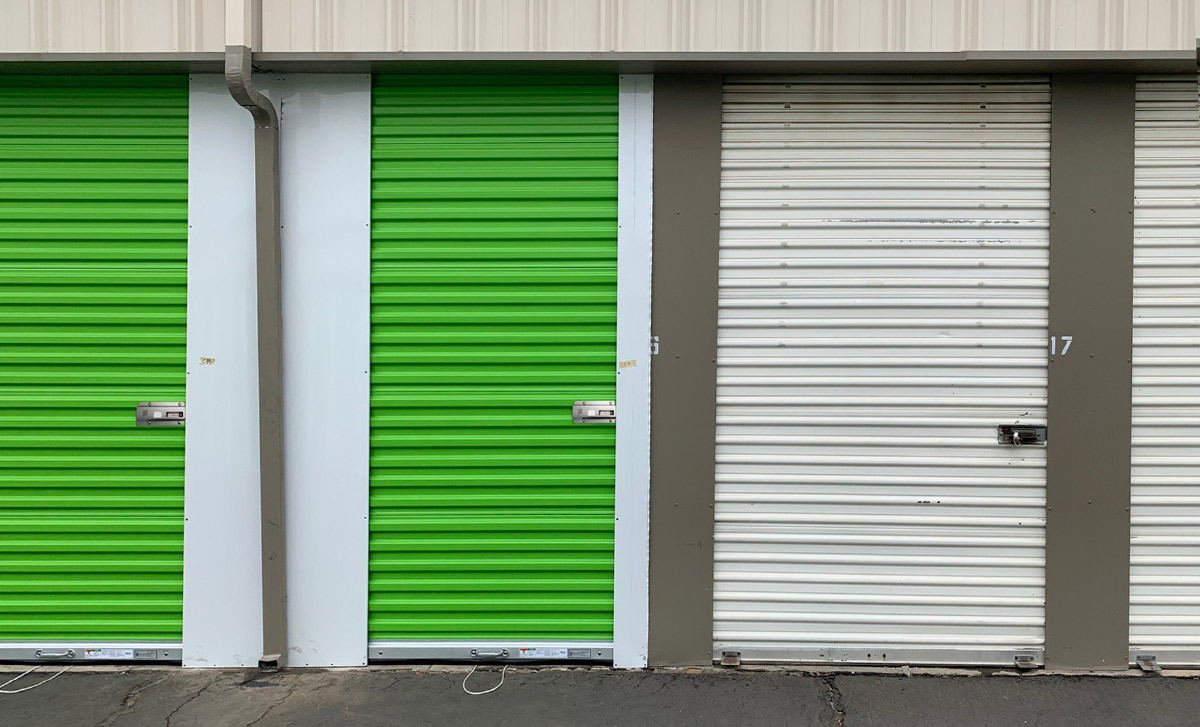
Janus International has a program designed to assist owner-operators who want to modernize their facilities in order to regain a competitive edge, reclaim higher rental rates, and remove potential liabilities: R3. Through R3 (restore, rebuild, replace), Janus’ crew has been refreshing old self-storages with new roll-up doors, hallway systems, unit mixes, and security features since 2009. Owner-operators can also repurpose idle land with the program and the company’s brand of relocatable MASS (moveable additional storage structure) units.
Additionally, Facilitate, an expanding part of the R3 division, offers comprehensive facility maintenance services to owner-operators who want to hire Janus to complete their routine maintenance and/or repairs. Per the company’s website, “no challenge is too large or too small for Facilitate.”
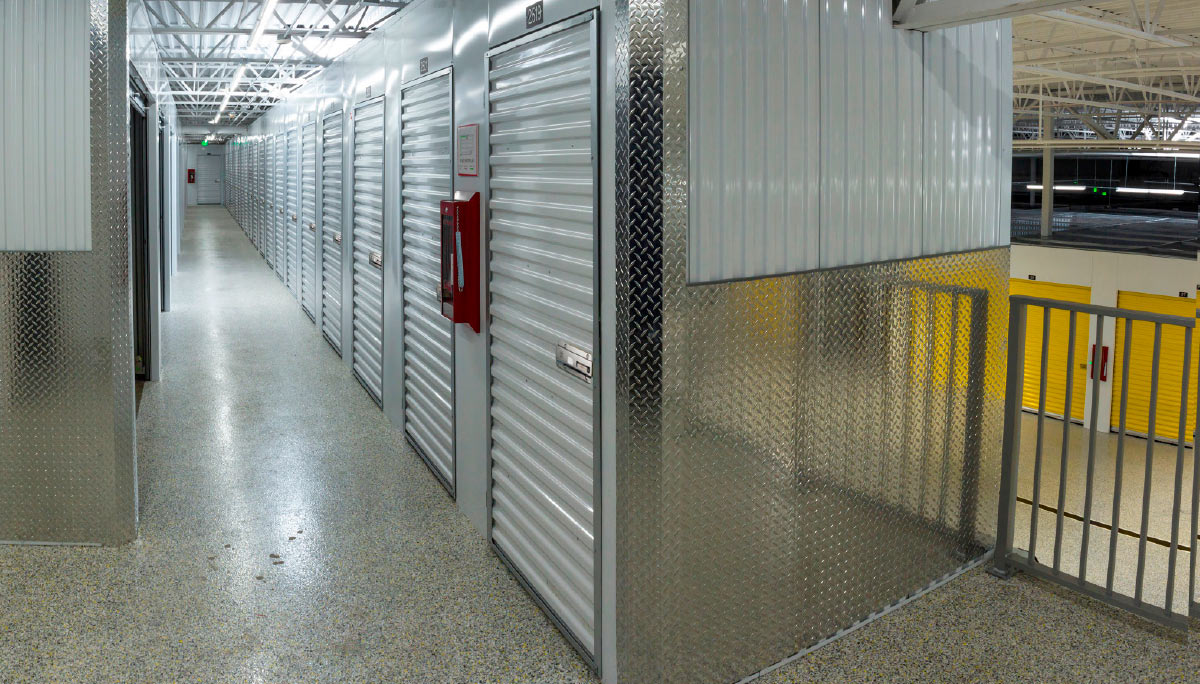



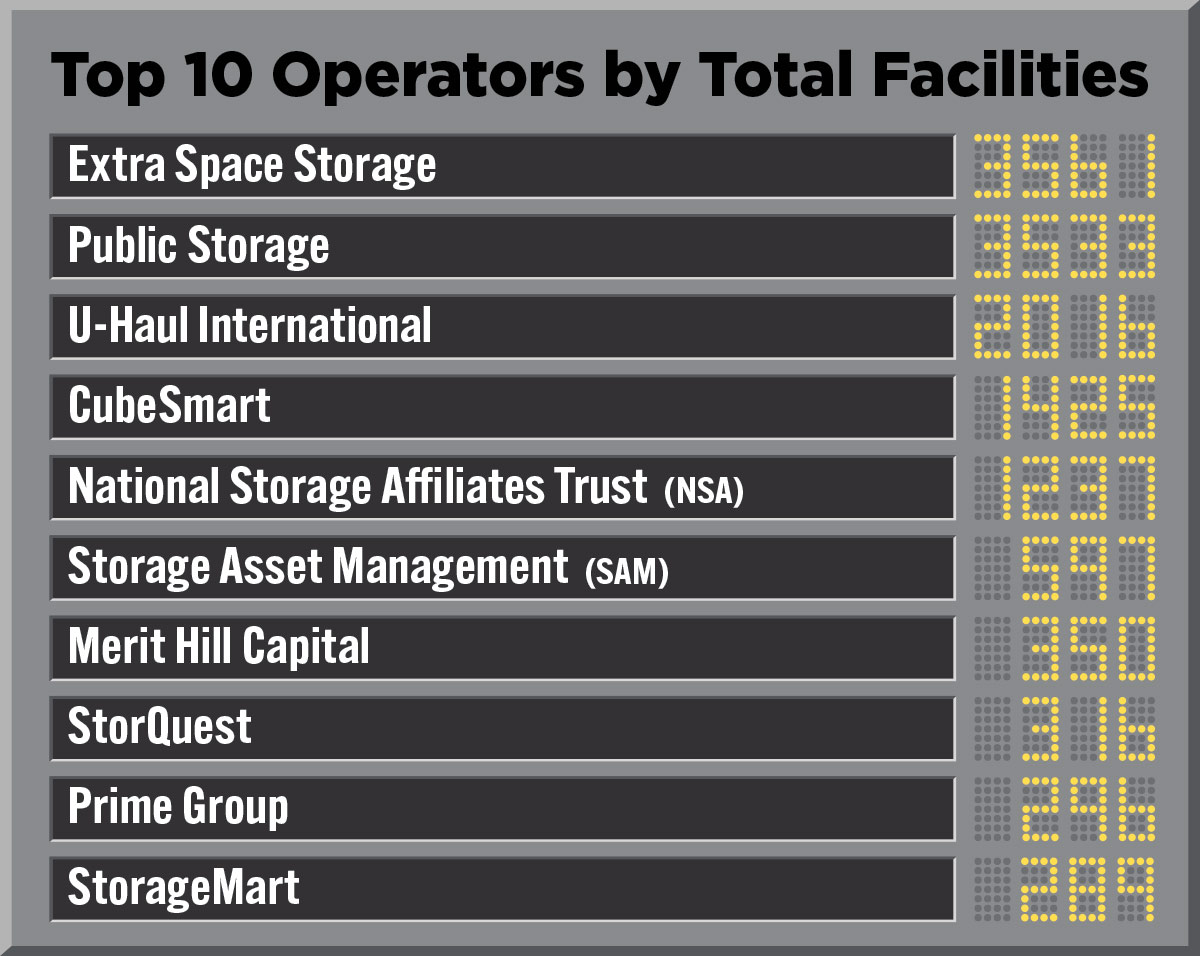



urrently, public REITs (real estate investment trusts) such as CubeSmart, Extra Space Storage, and Public Storage are lowering asking rates for first month rent to entice people to store with them only to raise rates over time.
Self-storage is unique in that it has month-to-month contracts on space. However, this can be tricky because public REITs may let you rent your first month for $50 but then charge you $150 the second month; not to mention, moving out of a storage unit can be a logistical nightmare, so more than 50 percent of customers tend to stay for at least 12 months.
Lowering asking rates keeps public REITs at high occupancy. They then make their revenue back from these loss-leaders through raising the rates of their long-term existing tenants. Anyone who leaves due to the rate increases is quickly backfilled through attractive asking rates. This keeps their same-store metrics looking good, which is appealing to investors and stockholders. However, this pricing shift has been tough for smaller operators to keep up with as they may not have the bank roll to follow a long-term pricing strategy like this.

Why is this important? Since the web rates are more like teaser rates that change aggressively after three or six months, the online rents are much less representative of what can be achieved when building a new store and starting to lease it out.
Here is an example of a facility DXD Capital is starting construction on shortly.
Web rates are closer to $200 for a 10-by-10, while the actual in-place rates that are being achieved are closer to $400. This is a mature REIT facility, so there have been many years of rental rate increases on existing tenants, but it illustrates the point: Facilities are achieving higher rates (in the short and long term) that are higher than the web rates would indicate.
Self-storage development tends to attract merchant developers that used to build office or retail, but it is becoming clear that to be a great self-storage developer you need to live in this space to catch nuanced strategic changes made by the REITs.
autious optimism prevails for the self-storage asset class for improvement in operations and cap rates in 2024. As a result, our 4Q 2023 Self Storage Investor Survey increased an average of only 7 basis points this quarter to an average stabilized cap rate of 5.75 percent. This reflects a total of 53 basis points increase since our 4Q 2022 Investor Survey. Another highlight characteristic is that the survey indicates Class-A cap rates are essentially flat from the Q3 2023 data. The Q4 2023 data is focused primarily on overall capitalization rates, terminal capitalization rates, and discount rate (IRR). Key performance indicators are shown in the Segmentation by Investment Quality table.
(See Segmentation by Investment Quality Table)
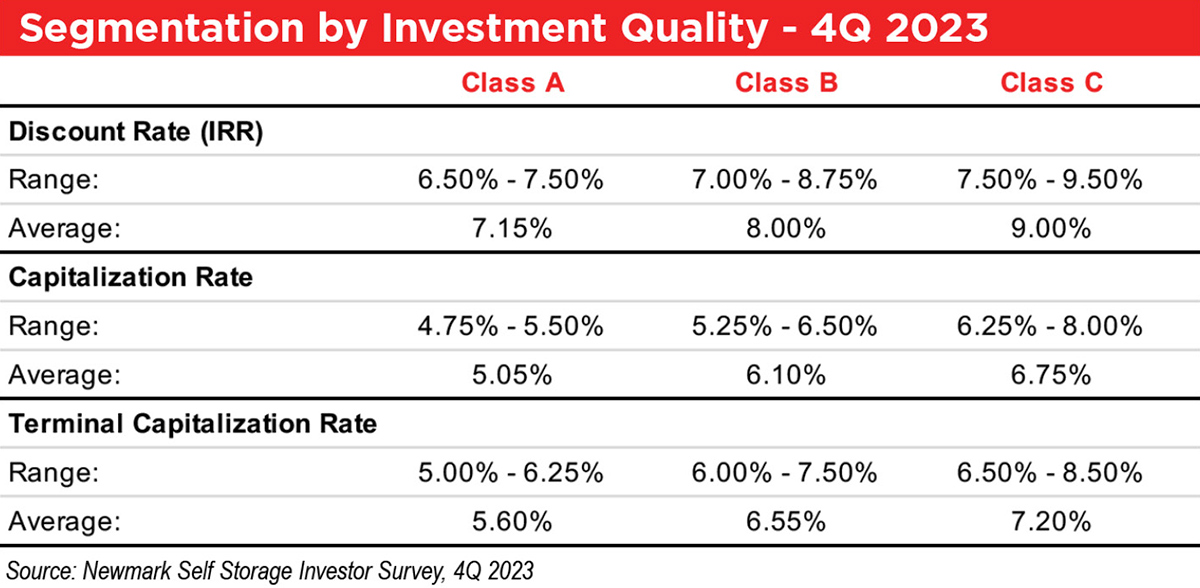
Perhaps it explains declining asking rents of 2023. Even in an environment of declining asking rents, actual rents increased significantly above inflation levels in 2023. Hence, the “cautious” optimism of market sentiment. Many expressed a belief that the Fed will lower rates, leading to a better lending environment resulting in lower cap rates and an improved transaction market. A great analysis of the 2023 environment and asking versus actual rates was put together by Aaron Swerdlin and his team at the Newmark Self Storage Practice from PSA Quarterly and Supplemental Public Filings summarized as follows:
(See Public Storage Same-Store Rental Activity Chart)
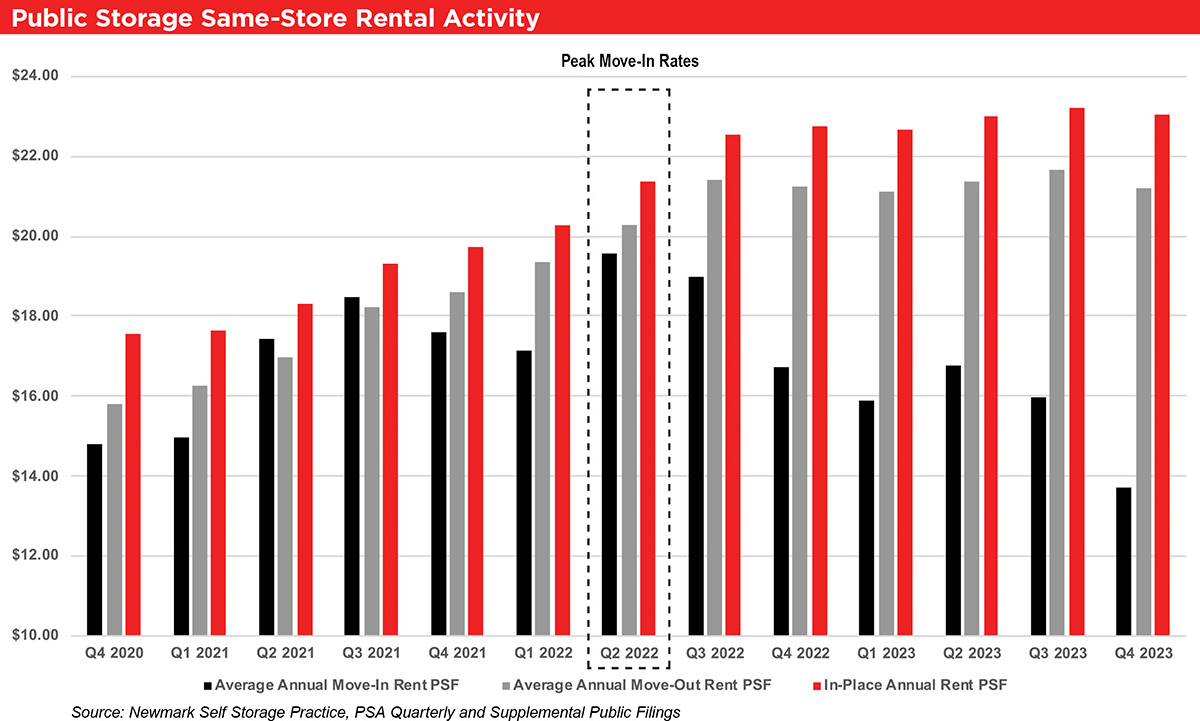
This highlights the importance of understanding the self-storage asset class, and it is another metric of resiliency even in a year (2023) of reversion to the mean or adjustment. Simply running an internet search on asking rates provides erroneous results of actual rents.
The self-storage team at Newmark Valuation & Advisory surveyed over 50 market participants about a wide variety of data points, including market sentiment, marketing time, and outlook. Survey participants include buyers, brokers, owners (small and large operators including REITs, national and regional owners), investors, lenders, and REIT analysts. Most interviews were in person, by telephone, or electronic conferencing.
The 4Q 2023 Investor Survey is also an indicator of market sentiment that 2024 will be a year of “significant improvement,” according to one participant. Many investors expressed confidence that interest rates will decline by Q2 2024 and the 2024 rental season will be superior to 2023, reflecting a return to patterns experienced prior to the pandemic—soft landing, not a recession. Based on our 3Q 2023 Investor Survey, participants remain cautiously optimistic about self-storage.
ver 40 years ago, when the industry was new, Ted Williams formed TLW Construction in Gilbert, Ariz., with a focus on building self-storage. After working as a CPA for several years, he found an interest in construction and became a general contractor in 1981, primarily building homes. Some friends asked Ted to build a 35,000-square-foot storage facility, and soon TLW found a niche in storage construction.
“The industry was still very small,” Ted says. “It was all single-story drive-up.” He says financing was tough because banks didn’t understand self-storage. Ted began building one or two facilities yearly and gained a reputation as someone who operated with integrity. His business philosophy was based on values he considers important.
“Honesty and fairness,” Ted says. “To me, fairness is a higher level. You can be honest and still treat someone unfairly. Also, I wanted to build something I was proud of. I didn’t care what it took to get that done.”
As both the industry and the company were growing, changes came in 2001 when Ted’s wife was struggling with a terminal illness. His son, Tarik, who had just graduated with a B.S. in construction management from Arizona State University, agreed to run the daily operations so his father could focus on matters at home.
In addition to computerizing the company, he instituted a document control system. “There was no contract,” Tarik explains. “My dad did all of his business with a handshake.” But the business world had changed, and Tarik felt the company needed better protection and better documentation for clients. He also instituted a safety program and a marketing program that included trade shows and print advertising.
Although Tarik previously had no interest in partnering with his father at TLW, his involvement would steer the future direction of the company. He had graduated at the top of his class just a few months after 9/11. Typically, Tarik would have enjoyed several offers from large construction companies, but the economic uncertainty caused by the 9/11 attack meant that no one was hiring.
“I looked at my dad’s company and realized the colossal untapped potential with what he had built with his hard work and honesty,” he says. Combining the reputation his father had earned with Tarik’s skills, the company was poised for success. “I had more of a marketing mind and entrepreneurial mind and skillsets I had developed through some internships in college with big national construction companies. We ended up partnering and grew the company.”
He also had an internship with a multi-million- dollar construction business and saw how a very large company organized their daily tasks and documentation. Tarik built TLW’s processes based on what he had seen. “You have to be a constant student of everything,” he says. “You need to be sponging up everything you can from every person you rub shoulders with, every business you come into contact with.”
With a stable business model in place, Tarik could draw on the company’s reputation and point to successful projects they had completed. In addition to these advantages, his father had instilled in his eight children the importance of a strong work ethic. “I was tying steel for tilted concrete walls when I was six or seven years old,” Tarik says. “My dad would bring home that steel and pay us for piece work. I was also sweeping out storage units at age 10 or 11.”
Instead of transitioning into a leadership position, Tarik had to be in charge from day one. He worked without a salary the first year while paying off debt. The economy was getting back on track and suddenly, Tarik had several job offers from other companies. However, he saw a promising future for the company his dad had founded. “My life would have taken a different path if not for 9/11,” he says.
One of the changes TLW made was to add Caliber Metal Buildings to its portfolio in 2006. “It was bogging us down waiting for suppliers,” Tarik says. “So, we decided to produce our own.”
Then, around 2008, the Great Recession hit, bringing the building boom to a jarring halt. “We were sitting on about $40 million in signed contracts that evaporated overnight,” Tarik recalls. “We were at a meeting in Santa Fe, N.M., ready to start a project. The bank president didn’t come in, so we waited. After nearly an hour, he came in looking white as a ghost. He said, ‘This Lieman Brothers thing has happened, and we can’t fund this project. We can’t do anything. Sorry.’ Then he walked out.”
That was just the beginning, Tarik says. Within the next month, every project in TLW’s pipeline had fallen apart. “It was the beginning of a very long and challenging timeframe in the construction and development world,” he says. “I think a lot of people who had been very successful had to fold. This went on for many years.”
Again, Tarik would go for years without a paycheck while the company recovered. He went back to selling real estate to make ends meet. “Everything I had done professionally to that point had turned to gold,” he says. “It was a depressing time. Coming out of that, it was almost back to the bare bones. I’d get out in the field to work with the guys. It was a great time to be humble, to see what worked and what didn’t work during those good years, and to build back the business.”




He says, after extensive study, some developers are finding that a return to simple drive-up storage, or at least including as many drive-up units as possible in overall site usage, is the most profitable direction for their development goals.
“Construction costs are driven by land cost, land improvement cost, design cost, building size and type, and technology cost,” he says. “With simple drive-up storage, 100 percent of building construction costs and dimensions goes to net rentable units.” In contrast, he notes that with climate-control units, approximately 25 percent of the building area is lost to hallways and other space that will never collect rent.
“Construction costs tend to be less in drive-up units when compared to climate control by maybe 15 to 30 percent, depending on the complexity of the multistory, climate-control building,” Tarik says. “When factoring in the lost square footage built to net square feet of rentable space, the proportional added cost of climate control is more like 40 to 55 percent.”
He says that in many markets, particularly in areas of higher rents and lower land availability, drive-up units fetch equal or even higher rental rates than climate control, and they rent up more quickly. “Most markets will see climate-control units collect 15 to 25 percent more in rent than drive-ups,” Tarik says, “but this does not make up for the added proportional costs noted above.”
However, he says climate-control units will continue to be built, partly due to demand for them but also due to restrictive city codes and high land costs in urban markets.
Though the basic storage approach can be the most profitable option for some projects, Tarik says demand is still there in some markets for top-of-the-line facilities. “At the other end of the spectrum, there are developers who have found incredible value in the finest exterior and interior building finishes, expansive lush offices with coffee bars and play areas, inclusion of Bluetooth access control to gates and units, dozens of high-power cameras, and online rental capability,” he says.

“Tarik was TLW Construction,” Ted says. “If something happened to him, TLW would have died. He came to me and said he wanted to partner with critical individuals so that the whole company wasn’t just him.” Ted agreed to sell his share to three others.
“I call them the three legs of the stool,” Tarik says. With Tarik as president, the new owners are Curtis Ryan, vice president of finance; Devan Williams, vice president of preconstruction; and Blake Pfaff, vice president of construction.
Devan is the youngest of Ted’s sons and came to work at TLW as an intern while earning a degree in construction management. “I worked my way up to project engineer and then to project manager,” he says, adding that he’s proud to carry on the company his father founded. “A lot of people in the industry respect my dad,” Devan says. “The key thing we learned from him was work ethic. All my life, I watched his example of how to work and how to take care of what you are responsible for.”
Devan’s goal is to help provide steady growth and stabilization for the company. “We’re working to continue in the legacy my dad built, and that Tarik has had a big hand in,” he says. “A stable company that people can rely on.”
Ryan, a CPA, came to TLW shortly after Tarik came in. He worked as the company’s controller for two decades. The company now has 25 employees and Ryan says the new setup is structured so that it will be easy to scale up when necessary.
Rising costs and labor shortages during the pandemic caused some projects to be put on hold; however, he says the company has weathered it well. Ryan says rising interest rates have also caused some slow down, “but with self-storage, deals are usually not lost but just put on hold.” He is looking forward to seeing TLW grow. “I have nothing but good things to say about the company and the team,” Ryan adds.
TLW Construction builds all storage types, including single-story, multistory, climate control, RV and boat, facility expansions, conversions, and renovations. The company is experienced in using a full range of construction materials including tilted concrete, masonry, and all types of metal.
Since design flaws can be costly, both in time and money, TLW works with architects and engineers to bring their experience and knowledge during the planning and design phase and to promote cost and time efficiency in design and construction.
With a new project underway in Texas and more in the works, the company is expanding into other Southwest markets. However, Arizona remains TLW’s primary market, where Tarik serves on the board of directors of the Arizona Self-Storage Association. He has also authored several articles in industry publications and has been a keynote speaker at industry conventions.
In addition to the values on which his father built TLW Construction, Tarik has followed some of his own principles that continue to guide him during the industry’s ups and downs. “Don’t quit,” he says. “Take responsibility. Be nimble.”
elf-storage has become the darling of the real estate industry over the last several years. Articles espousing the virtues of the business (limited capital expenditures and few, if any, employees) and phrases like, “recession proof” and “anyone can do it,” have driven the feeding frenzy in our business. As a veteran of the industry, I can tell you with confidence that none of those ideas are true. There are shades of truth to each of them, but anyone who’s been an operator or investor in this business over the long term knows the fallacies of those statements. In this section, we will delve into the reasons why management companies are (mostly) essential, the critical role of an on-site manager, and the steps to take when opening a new storage facility. We will also explore how changing technology is making it increasingly challenging for small operators to compete with larger, tech-savvy players.
Analysts on Wall Street constantly speak about the fragmentation in the storage industry as one of the attributes that make it ripe for sophisticated investors to be successful. While still true that about 50 percent of the industry is owned by small operators, that number has been decreasing over the last decade. Small, medium, and large companies continue to be bought out, with the biggest example being Extra Space’s acquisition of Life Storage. In addition to ownership, the third-party management offered by almost every large public and private company puts even more control in the hands of the biggest companies. My bet is that storage is moving in a similar direction as the hotel industry. There used to be hundreds of brands and now there are three: Marriott, Hilton, and Hyatt.
The other transformation happening right now is being driven by the ever-evolving landscape of technology. Before the pandemic, only private operators rented storage units online, along with one REIT. The other REITs said they would “never” do it. Lo and behold, 20 to 40 percent of leases are now signed online for sophisticated operators. Sixty percent of tenants used to find facilities with drive-bys. Now 60 percent of tenants find us through online channels, with Google being the largest funnel. The rise of technology has allowed for unmanned stores, sophisticated minute-by-minute rate changes, real-time understanding of demand and competitor changes, ability to monitor and listen to every phone call, use of business intelligence (BI) software to understand performance in real-time, etc. In addition, most companies are starting to use AI for a plethora of tasks that I’m sure will be fleshed out in ways we can’t even imagine yet today.
Call Center, Autopay, Reputation Management, Operational Goals, Procedures, etc.
The list goes on about how to run an effective and profitable storage facility. These last few things could be viewed as “optional,” but I would argue that they could be the difference between great results and mediocre ones.
You’re probably thinking that if 90-plus percent of small operators are leaving money on the table, then why don’t they hire a third-party operator? In my experience, there are three main reasons: control, expenses, and big aspirations.
For the people who subscribe to bucket No. 1, it is hard to convince them to hire a third-party management company, although it would probably benefit them in the long run. For the people in the second bucket, what I generally say to those folks is that most third-party operators generate +/- 10 percent of revenue in “other income,” which more than covers the fees and those other costs. Those other income items come before revenue management and economies of scale on other expense items, which is where third-party managers really add value. For the person in bucket No. 3, this is the one that I would subscribe to if I was just starting out. That being said, you can hire a third-party manager until you get the scale to operate on your own and get a free education along the way while you focus on building the portfolio.
These three reasons that folks don’t hire third-party management companies should illustrate that logically it makes sense to hire a third-party manager. Organizing all the day-to-day aspects of running a facility is a challenge, and it takes every one of the items I listed to have a successful storage facility. A property with too few or poor Google reviews all of a sudden won’t be on the front page of organic results. A wrongful auction could put the owner in months of legal hell. The consolidation of the industry has also made it almost impossible to compete in many markets if you don’t have scale. A one-off property in a big market can be effectively invisible online without a huge budget behind it.
Operating a one-off store creates more work, more risk, and nine out of 10 times makes less money than hiring a management company. As far as I’m concerned, it seems like a no-brainer.
I’m clearly biased as the owner of a management company as to what benefits can be provided, but ultimately what it comes down to is that running a storage facility to its full potential is really, really hard. Why deal with the hassle? Don’t you have better things to do than talk to the fire department at midnight when someone gets locked in behind the gate? If someone else is realistically going to make more money for you than you running your storage facility, shouldn’t you let them do that so you can focus on whatever it is that you’re really good at?
The self-storage business is changing quickly. To stay on top of new technologies, latest trends in revenue management, pay-per-click strategies, and the general movement in micro and macro markets is grueling. Big storage companies have the resources to stay on top of these changes, read the articles, go to the conferences, and maintain relationships with others to hear and understand the challenges they’re facing. Adapting to the world as it changes is what good companies do, and if you hire the right management company, it’ll pay dividends for you both in saved time and money.

here’s a saying in Florida that there are two types of people: those who are boaters and those who plan to be boaters. Whether this is a Sunshine State phenomenon or not, it’s no surprise. Recreational boating has been a thing ever since kings and their royal regattas took to the Thames River in England back in the mid-1600s. Of course, today recreational boating is not just for royalty.
In America alone, QuickNav statistics reveal that nearly 100 million people go boating each year, and nearly 12 percent of U.S. households own a recreational boat (sales surged 40 percent during the COVID pandemic, making boat ownership more popular than ever). Another interesting statistic: The average boat in the U.S. is operated just 54 days per year. This means that many boat owners need a place to keep their vessel when they’re not navigating open waters.
Storage may simply be a necessity for some captains. There are nearly 360,000 homeowners associations (HOAs) in the U.S., representing more than 40 million households. Those living under HOA rules must obey the governing documents, many of which limit the owner’s choices, including the right to keep boats on property. Making this more of a hardship for boat owners, less than 14 percent of existing HOAs offer storage and/or parking for watercrafts within their communities. So, the only option is to find an off-site boat storage facility.
Many savvy self-storage developers have been able to build their storage facilities within the confines of the HOA-governed community, or nearby, alleviating the boat storage problem for these residents. If you’re located near HOA-restricted neighborhoods or happen to be in an area where boating is a popular pastime, offering boat storage can be highly lucrative for your operation and beneficial to boat owners.
Other boat owners, typically those who have made considerable investments in their boat, will want fully enclosed storage. “This provides the most protection,” says Scott Ramser, managing general partner with the Ramser Development Company, which has an established portfolio of quality RV and boat storage, self-storage, and industrial outdoor storage assets. “Exposure to the elements such as sun, rain, and snow can take a toll on a boat’s appearance and performance. Enclosed storage helps protect boats from Mother Nature and subsequent weather-related damage. This can also be important in coastal areas where flooding and hurricanes can be a big concern when it comes to boat slips.”
Continues Ramser, “While enclosed storage will be the most expensive to build, it will also bring in high rental rates.”
Length of stay is another consideration when it comes to storage options. For much of the country, recreational boating is a seasonal pastime. Some boat owners may keep their watercraft in a boat slip during the warmer months and look to store their boat on land during the off-season. By offering flexible rental agreements, you can attract short-term and long-term rentals.
10 Federal Storage is one self-storage provider that offers a high level of security for boats. “We offer both uncovered parking spaces and interior units with enough space for parking, so boat owners have options when they rent from us,” says Andrew Capranos, president of 10 Federal, which operates 20,000-plus storage units at more than 75 locations across 14 states. “Our facilities use facial recognition and other AI technologies, and that’s important to people storing expensive boats.” Capranos points out that many facilities also use drones, providing an “eye in the sky.”
“Our night watchperson works in our corporate office and watches video feeds from all of our properties every night,” says Capranos. “If there is suspicious activity, a drone can go in for a closer look. This is the type of security that makes boat owners feel safe storing with us.”
Making self-storage even more attractive for boat owners is the fact that some insurance policies provide discounts for keeping vessels in a secure and dry location when not in use. According to Discover Boating, boat owners should always ask their insurance provider about what is commonly referred to as a “lay-up” discount. “You’ll have year-round coverage with a discount for the months your boat is in dry storage,” according to the news outlet. Self-storage owners may want to let tenants in on this secret when someone is considering renting a spot.
But boating amenities can go much further than retail items. “I recommend including a wash station, where owners can clean their boats when returning them to storage or picking them up, or flush the engine with fresh water,” suggests Ramser. “A dump station that allows them to unload wastewater into a septic or sewer system is also a big plus.”
Many of the facilities Ramser owns and manages also offer valet service, and employees are trained on how to carefully tow a boat to and from its parking spot or storage unit. Some facilities go as far as transporting watercrafts to a boat launch or fueling them up for the tenant, providing unlimited in and out service with advance notice.
For these types of services, it’s important to address them in the rental agreement. Include addendums that cover valet service, dump stations, and wash stations to be sure liability is properly allocated between your facility and the tenant. If you’re charging for these services, make sure the costs are clearly spelled out in the agreement. It’s best to always have an attorney familiar with this area of the law review the agreement to be sure you’re protected. The lawyer may also recommend you set up separate entities to handle some of the “riskier” parts of the operation, such as transporting boats to a launch.
Finally, if your operation also includes traditional self-storage units, you may consider offering one to a boat owner storing their vessel at a discount (you’ll earn more from the boat space rental, so it is beneficial to do so if it helps convince them to store with you). Many boat owners may want a unit to store related items, such as fishing gear, water sports equipment, or even jet skis.
n an era where self-storage facilities are no longer merely practical spaces but integral components of urban landscapes, the importance of design has never mattered more. The fusion of functionality and aesthetics that brand modern facilities and shape customer experiences can define a facility’s success. The former utilitarian approach to simply storing customers’ belongings has evolved. Self-storage facilities are now architectural statements, aiming to garner both customer and community appeal. Here are six tips to help you achieve that objective.
1
After determining a facility’s target rentable square footage and unit mix, creatively applying those factors to a site’s layout will begin to establish functionality. Further applying local zoning regulations, site flow dynamics such as traffic and parking, and of course budget, will also have a significant impact. Will a site have two-way traffic or only one-way traffic with separate entry and exit gates? Does the site need to accommodate RV parking? Is snow removal a concern? Is it more cost-effective to have 20-, 30-, or 40-foot-wide non-climate-control buildings? It is easy to see how each of these decisions can have a drastic bearing on the overall design, and success, of a facility.
Access system keypad placement, for example, can be tricky to get right at your entry gate. The wrong spacing can make it nearly impossible for larger vehicles to get close enough to the keypad to enter the code without having to completely exit the vehicle and then also navigate through the gate’s opening. Inadequate bollard placement can leave a facility susceptible to costly damage. Smart technologies whose infrastructures are not a part of the early design process can lead to costly revisions and change orders. Worse, they may not serve customers well if their placement is not intuitive or convenient. Further considerations for the serviceability of technologies, utilities, etc., are also critical throughout the facility’s design.
n the densely populated cores of cities, where land is a premium commodity, the self-storage industry is undergoing a transformative shift. This shift, from traditional single-story horizontal facilities to multistory vertical structures, is not just a trend but a necessity, driven by the unique challenges and opportunities of urban space management. Our own self-storage projects in cities like Seattle and Portland are key examples of these revolutionary responses to urban space constraints and evolving building codes.
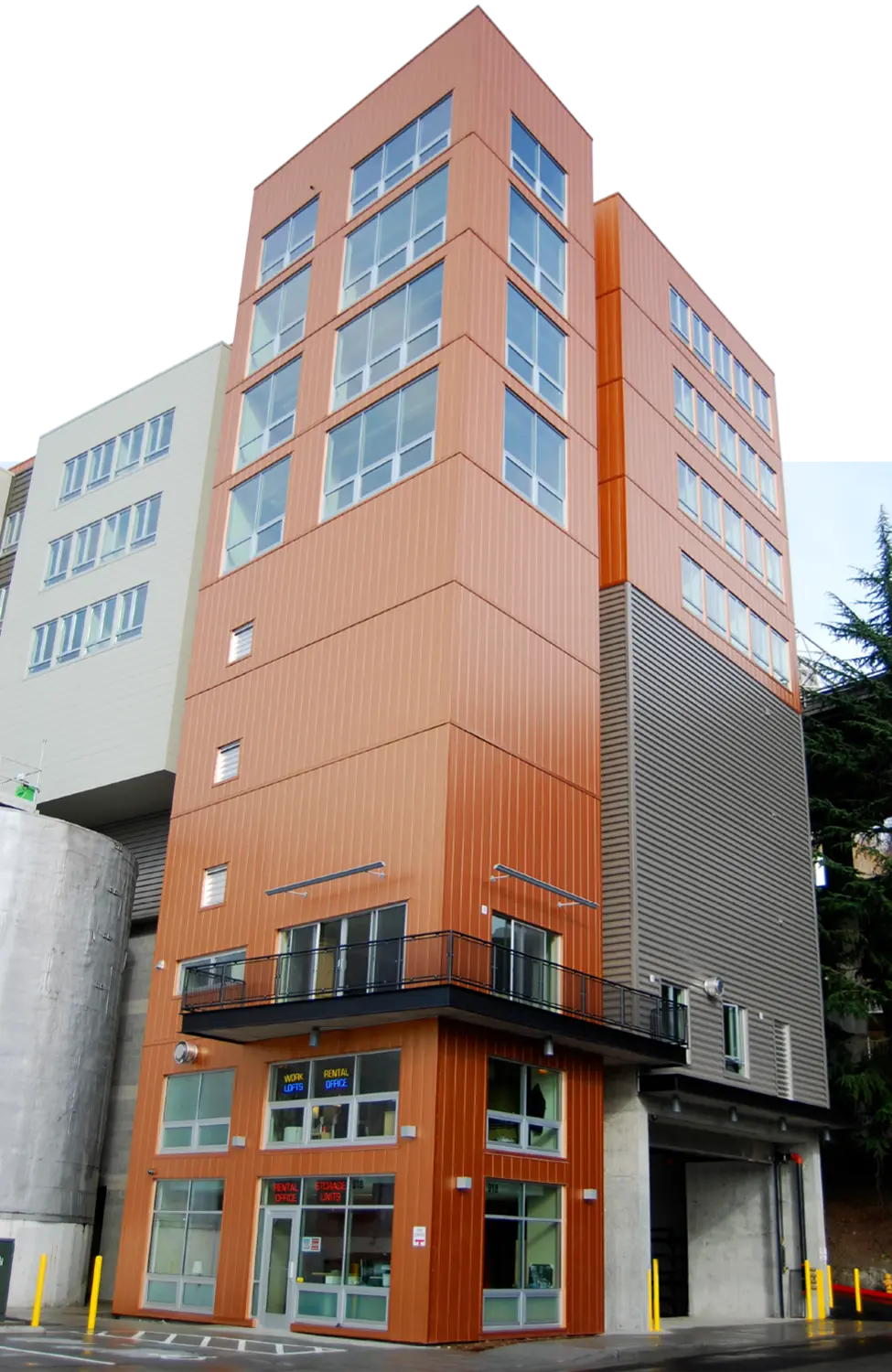
Gone are the days when self-storage facilities were only relegated to the outskirts of town. In urban centers, the demand for storage space is on the rise, yet the availability of land remains static. This challenge has led our team to reimagine self-storage, transitioning from sprawling facilities to multistory structures. There are pros and cons between traditional and vertical storage solutions, including:
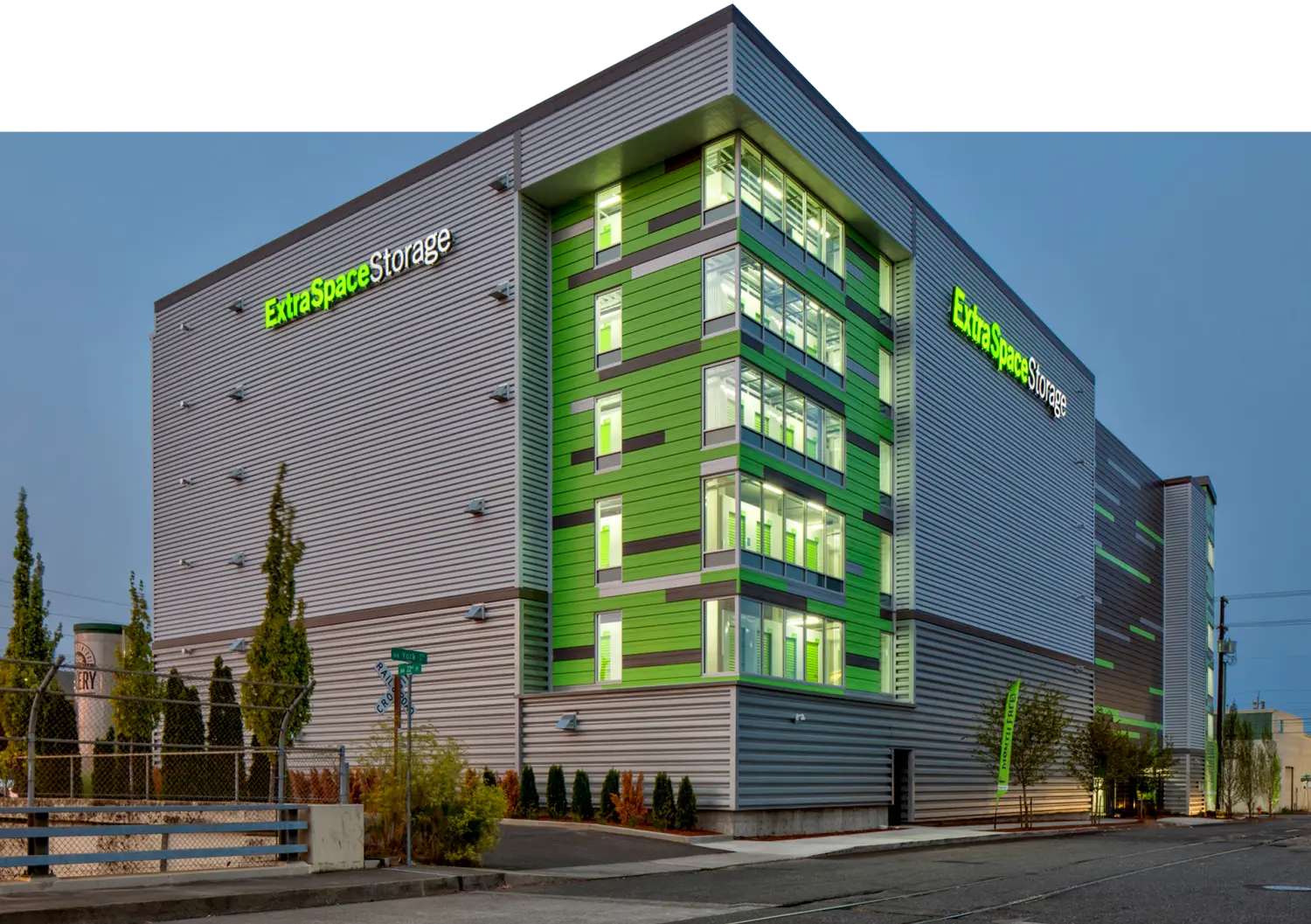
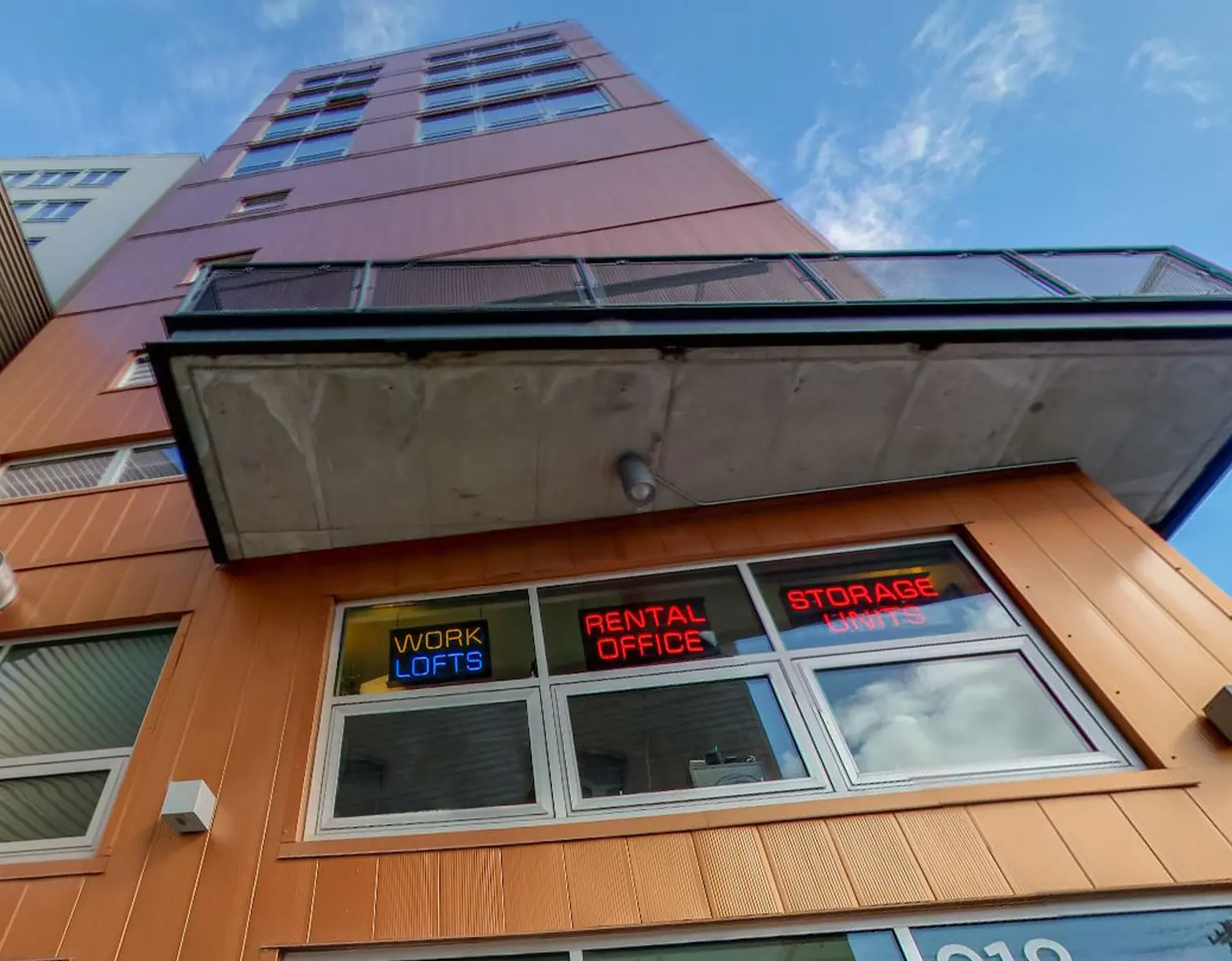
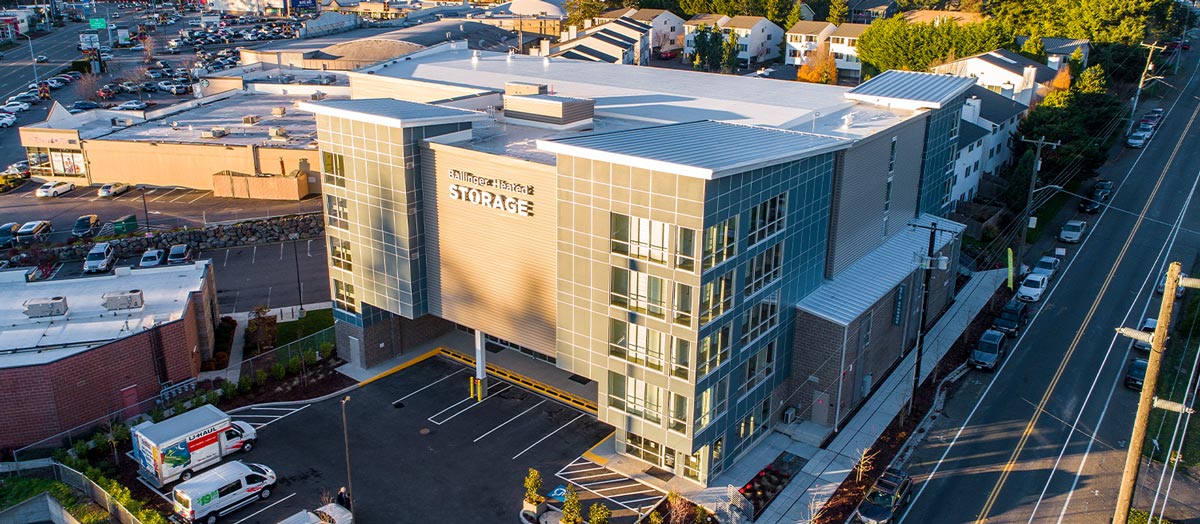
- Cost Efficiency – Traditional single-story facilities typically require less initial investment due to simpler construction and lower land costs outside urban centers. However, vertical storage solutions, while having higher upfront costs due to complex construction and urban land prices, offer greater revenue potential per square foot. By utilizing vertical space, these facilities can accommodate more units in a smaller footprint, leading to higher returns over time.
- Time Efficiency – The construction time for traditional, single-story storage units is generally shorter, given their simpler design and construction. Vertical facilities, in contrast, require more time for construction due to their complexity and compliance with stricter urban building codes. However, the long-term time efficiency of vertical storage is notable, as these facilities can serve more customers in dense urban environments, leading to quicker lease-up and potentially a faster return on investment (ROI).
- Space Efficiency – Vertical storage facilities excel in space efficiency. In densely populated urban areas, where land availability is limited, going vertical is a strategic way to maximize the use of limited space. This contrasts with traditional storage facilities, which require large land areas for generally larger storage units and vehicle maneuvering and are often located on the outskirts of urban centers, making them less accessible to city dwellers.
- Structural Design Considerations – Vertical self-storage facilities require robust structural designs to ensure safety and stability. This involves advanced engineering to manage the load-bearing requirements of multistory buildings, especially in areas prone to seismic activity or extreme weather conditions.
- Construction Type Considerations – As a building grows in area and number of stories, the building code requires an increase in the construction type to mitigate the associated risk. The code outlines several methods for constructing taller buildings, many of which involve the use of a podium base.
- Zoning Regulations and Compliance – Navigating zoning regulations is a significant challenge for vertical storage solutions. Urban areas often have stringent zoning laws, requiring developers to obtain various permits and adhere to specific construction standards. This process can be time-consuming and costly, impacting the overall feasibility of such projects.
- Community Responses and Integration – Community response to vertical storage facilities can vary. While these structures provide a much-needed service in dense urban areas, they must be designed to blend seamlessly with the urban landscape. Aesthetic considerations, traffic impact, and the facility’s contribution to the neighborhood’s character are essential factors in gaining community acceptance and support.



In Seattle, the scope of our work is further highlighted. A standout project is a 10-story high-rise (Type 1B construction) that combines storage, work lofts, parking, and a residential unit, exemplifying the versatility of vertical self-storage in urban settings. Another vertical storage project within the greater Seattle area (Shoreline, Wash.) features a five-story, effective mix of two stories of Type 1A construction with three stories of Type 2B, further demonstrating the creative possibilities unleashed by the new building codes.
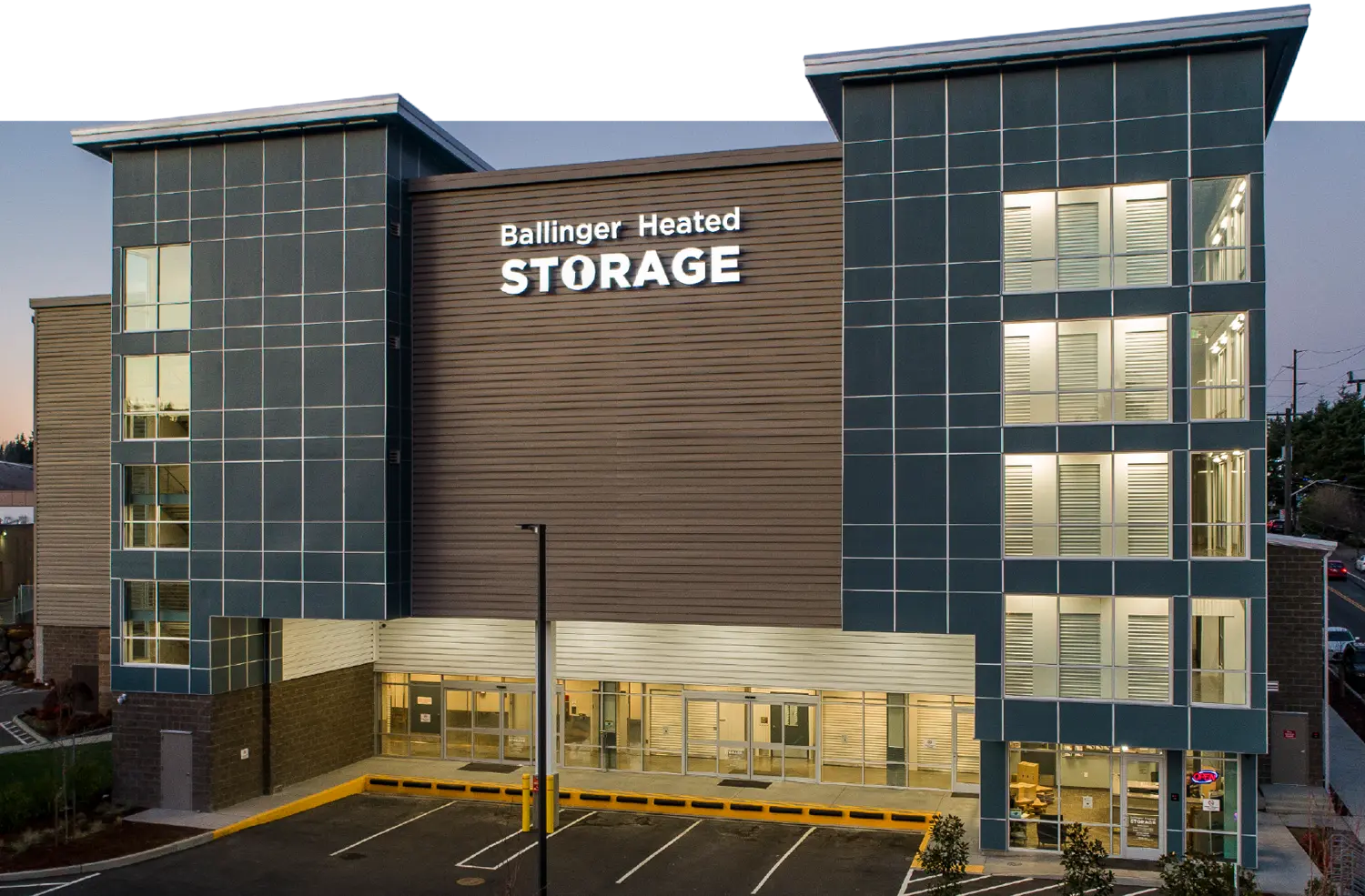
Both Seattle’s rapid growth and Portland’s strategic urban management highlight the urgent need for innovative self-storage solutions. Vertical self-storage not only addresses the scarcity of available land but also offers a sustainable approach to urban development.
To provide a broader perspective, it’s important to note that different regions and cities across the United States have their own modifications of the IBC, tailored to their specific environmental and urban challenges. For instance, cities in California may have stricter seismic design requirements, while those in hurricane-prone areas like Florida have different wind load specifications. Both the states of Oregon and California have rewritten the IBC to their own standards, but they’re still based on the risk forming principals of the IBC.
Comparing these changes to other urban areas reveals a diverse approach to city development and construction standards, influenced by regional factors such as climate, geography, and density. Some areas might adopt more stringent measures for fire safety or environmental sustainability, while others focus on flexibility to encourage development.
Challenges And Limitations
- Increased Complexity in Design and Construction – The allowance for higher buildings under the new code requires more complex architectural and engineering solutions. This includes considerations for structural integrity, safety, and compliance with higher standards.
- Cost Implications – While the new code allows for greater height and density, it can also lead to increased costs. More stories mean more materials, advanced safety features, and possibly higher labor costs.
- Regulatory Compliance – Navigating the new code can be challenging for developers and architects. Ensuring compliance with the latest standards demands thorough understanding and often necessitates consultation with experts in building code regulation.
- Community Impact – Higher buildings can have a significant impact on the surrounding community. They can alter the skyline, block views, affect traffic patterns, and have implications for local infrastructure.
- Environmental Considerations – Taller buildings can have different environmental footprints, requiring careful planning regarding energy efficiency, waste management, and sustainability practices.
Vertical self-storage not only addresses the scarcity of available land but also offers a sustainable approach to urban development.
- Design – Vertical storage facilities offer a canvas for architectural innovation. Unlike the traditional, utilitarian appearance of horizontal storage facilities, vertical structures can be designed with modern, aesthetically pleasing elements that blend with or even enhance the urban skyline.
- Customization – These buildings provide opportunities for unique branding and design customization. Creative use of façade treatments, lighting, and signage can turn a storage facility into a landmark that contributes positively to the urban aesthetic.
- Mixed-Use Potential – Vertical self-storage facilities can be integrated into mixed-use developments, combining storage with residential, retail, or office spaces. This integration not only maximizes land use but also contributes to the vibrancy and diversity of urban neighborhoods.
- Enhancements – By going vertical, storage facilities contribute to urban density, a key component in the development of walkable, transit-oriented neighborhoods. This density can lead to more efficient land use and better integration with other urban functions.
Environmental Impacts
- Reduced Footprint – Vertical storage facilities offer a reduced land footprint, which is especially beneficial in urban areas where land is scarce and valuable.
- Energy Efficiency and Stormwater Management – Modern vertical storage buildings are at the forefront of combining energy efficiency with stormwater management. Designed with solar panels, energy-efficient lighting, and HVAC systems, these buildings significantly lower environmental impacts. Additionally, green roofs and permeable surfaces play a crucial role in managing runoff, easing the load on urban sewer systems.
- Sustainable Materials and Construction – The construction of vertical storage facilities offers the opportunity to use sustainable materials and construction practices. This includes the use of recycled materials, low-impact construction methods, and sustainable waste management during construction.
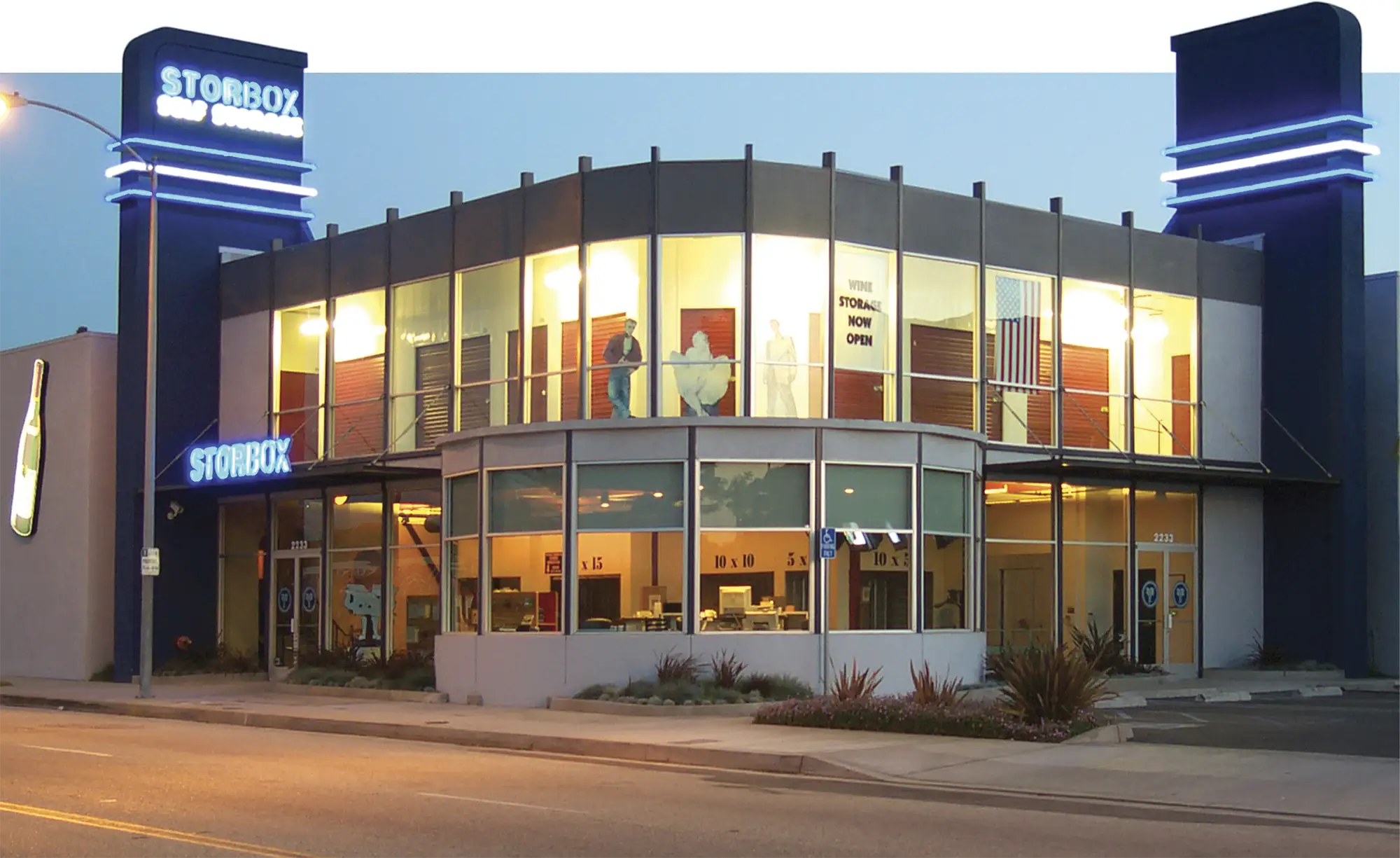
ith a retro flare and lighting reminiscent of the neon signs of the 1950s, StorBox Self Storage in Pasadena, Calif., showcases its offerings through two stories of storefront glass at its office entrance, while life-size images of Marilyn Monroe, James Dean, and Elvis Presley safeguard the valuables stored inside. StorBox, owned by Barnard Investments and designed by Ken Carrell of ARE Associates, features 550 wine lockers and 70 high-security art units secured behind a vault door. In total, the approximately 100,000-net-rentable-square-foot property has nearly 1,000 units.
Formerly a single-story warehouse, the building had undergone seven expansion remodels before being converted into self-storage. According to Carrell, differing floor levels from the previous expansions necessitated the construction of ramps within the two-story structure. And the owner’s request for units with exterior access required plastic curtains to minimize the loss of cooled air.
After tearing down the original building, a spacious, art-deco themed office was built in its place. The office has a conference room, retail, and display units.
StorBox was completed within a year and opened in June of 2001. It is fully stabilized with an occupancy rate of around 96 percent.
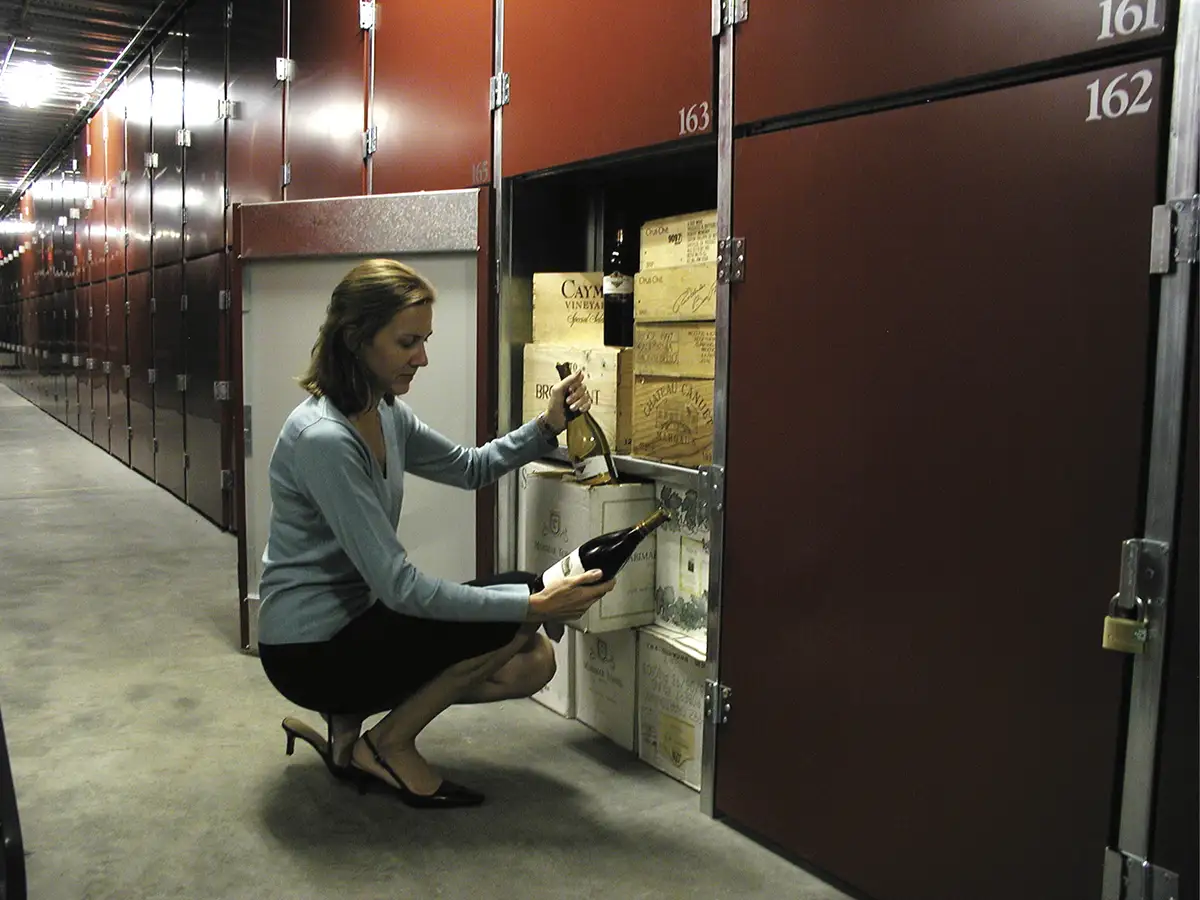
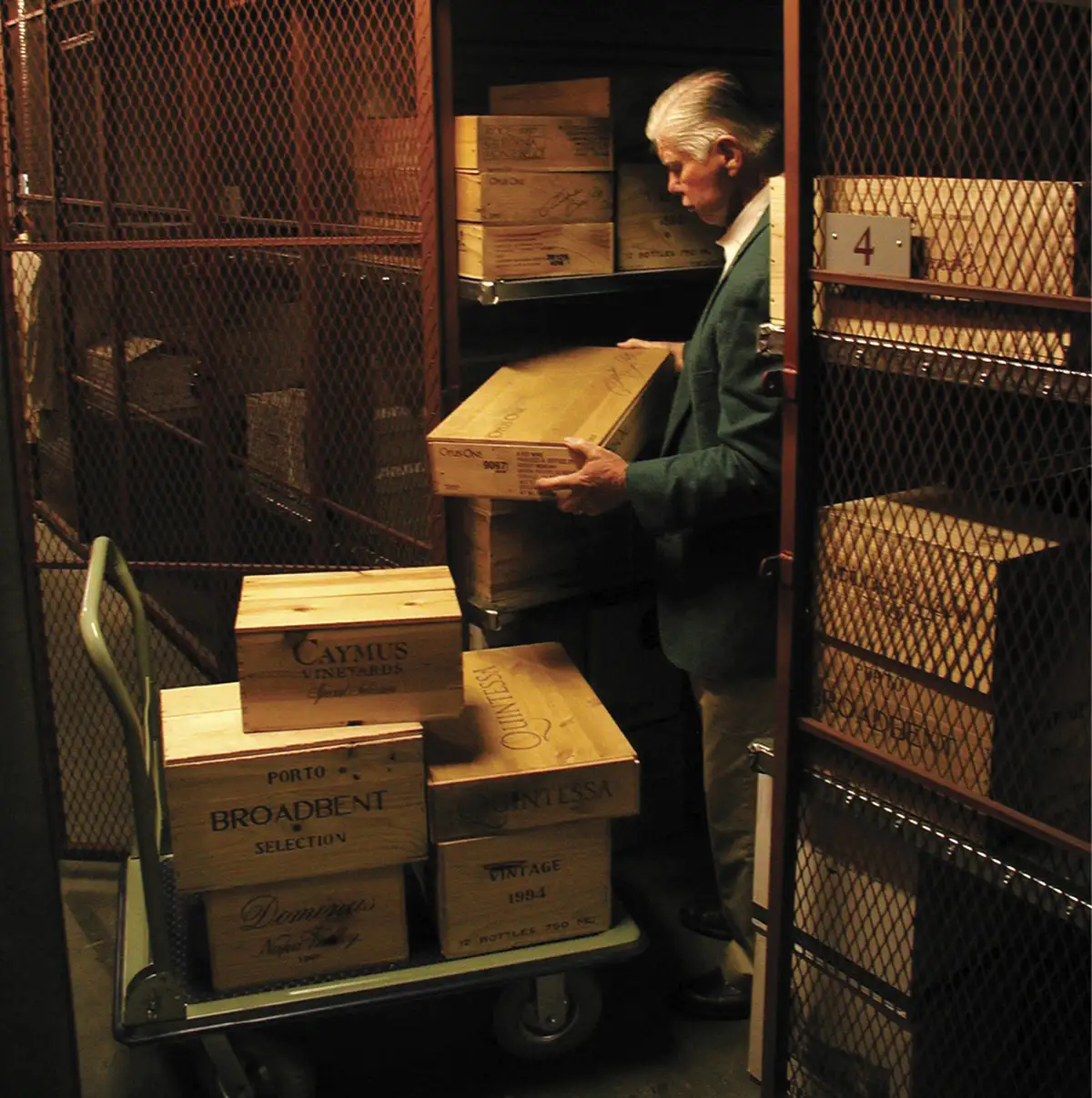

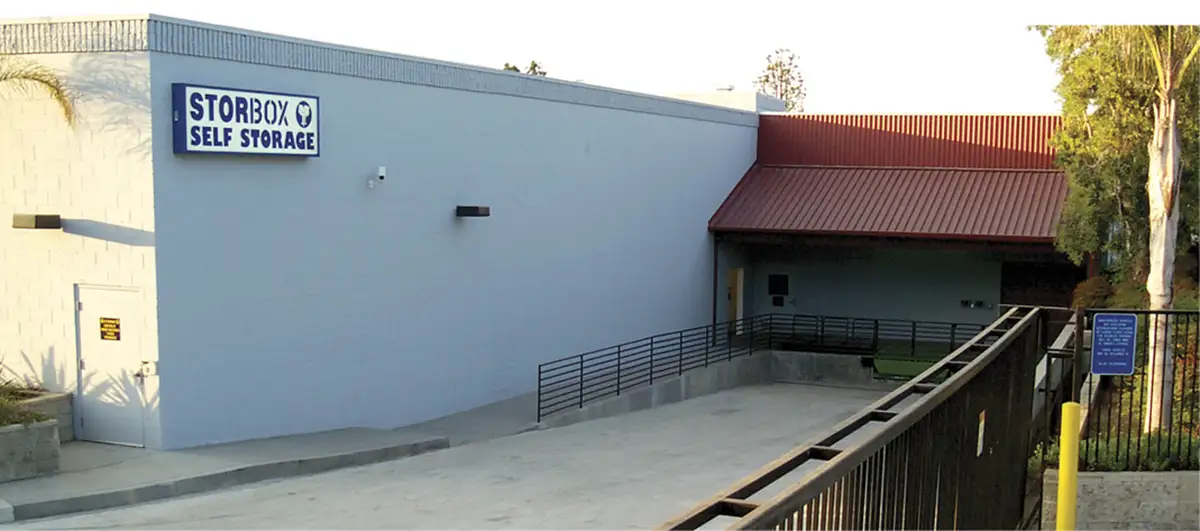
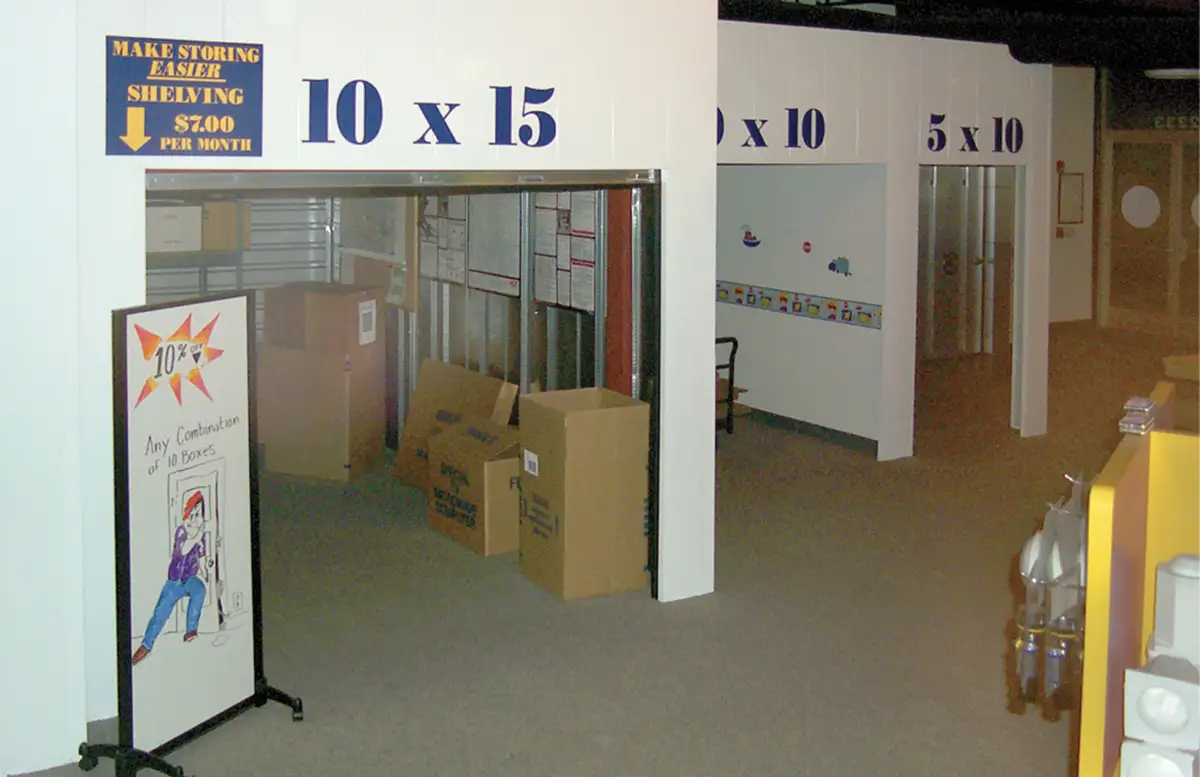

he record-low interest rate and easy-money environment the self-storage industry enjoyed from mid-2020 through mid-2022 sadly came to an abrupt end in 2023 as interest rates skyrocketed and credit markets tightened up. What does 2024 have in store for self-storage owners seeking financing for a new construction project, the acquisition of a new property, or simply the refinance of an existing facility?
In the first quarter of 2024, the cost of debt is substantially higher than it was only a short time ago, and many commercial real estate lenders have become more selective, more conservative, more expensive, or have stopped lending for the time being.
The good news, however, is that self-storage is still considered by most lenders to be a very desirable asset class in comparison to most other commercial real estate types. More good news was revealed in mid-December when the central bank signaled that its inflation-fighting strategy of raising rates was likely done and that multiple rate cuts were on the table for 2024. U.S. Treasury rates have begun to ease but are still a long way off from the lows of the prior few years. Despite these positives, self-storage borrowers will very likely continue to face some financing challenges into 2024 and beyond.
However, as with most good things, the most favorable self-storage financing environment on record finally deteriorated towards the end of 2022 and continued throughout 2023. In the battle to curb post-pandemic inflation, the Federal Reserve quickly reversed course and increased the fed funds rate at a breakneck pace (11 times from March 2022 through July 2023) to the highest level in 22 years, causing borrowing costs to quickly skyrocket and causing major stress in the banking industry. Although the banking industry did not collapse as it had during the Great Recession of 2008, a small number of banks failed as a direct result of fed policy and many other banks quickly pulled back from commercial real estate lending to varying degrees or stopped lending altogether.
As the fed funds rate quickly increased, other short-term rates followed in an almost lock-step fashion. Prime Rate increased from 3.50 percent to 8.50 percent and 30-day SOFR increased from 0.05 percent to 5.00 percent. Loan payments for adjustable-rate loans more than doubled for many borrowers, prematurely depleting interest reserves and requiring additional borrower cash infusions for many construction and value-add projects. While existing fixed-rate borrowers did not suffer the same fate, interest rates for new fixed-rate loans more than doubled from the 3 percent to 4 percent range to the 7 percent to 9 percent range as the five-year and 10-year U.S. Treasury rates climbed over 400 basis points from mid-2020 lows to almost 5.00 percent by October of 2023.
Because of the stress created primarily by the quick and drastic run-up in short-term interest rates, many banks do not have the appetite or capacity to make new commercial real estate loans. Compounding the issue is the fact that payoffs of existing loans on the balance sheet have slowed, further hindering banks from recycling their outstanding capital into new loans. For the banks who are still actively lending today, many have limited allocations for new loans and typically reserve that capacity for their existing customers or new customers who can bring deposits to the bank.
For these reasons and more, 2024 may be the year that non-bank lenders, including CMBS lenders, life insurance companies, debt funds, and others, pick up some of the slack from the banking sector. The lending capacity of these non-bank lenders has not been affected nearly to the same extent as the banking sector.
NOI underwriting has also become more challenging as the self-storage industry operating performance has cooled off over the last year or so. Nationally, self-storage occupancies and “street” rental rates (rates charged to new customers) have begun to drop from their pandemic-fueled highs, resulting in challenges to continued revenue and NOI growth. While increasingly sophisticated revenue management tools have preserved or even grown existing customer rental income (ECRI), ever-increasing insurance premiums, real estate taxes, and payroll expenses present further challenges to NOI growth. In addition to higher interest rates, these income and expense trends could very well further limit loan proceeds for an existing property. Underwriting for new construction projects shares all of these challenges and is also hampered by increased interest carry, slower lease-up projections, and lower rental growth projections.
- Keep perspective that today’s lending environment is not unlike others that we have experienced in prior economic cycles; there is still plenty of capital out there for our industry, albeit at lower leverage and higher rates than in the recent past.
- While there is a glimmer of hope that interest rates will back off a bit from recent highs, interest rates in the 3 percent to 4 percent range were a short-lived “blip” and are extremely unlikely to return without a major financial crisis or detrimental U.S. domestic or global event.
- Carefully evaluate new construction and acquisition opportunities, incorporating assumptions that include today’s interest rates are likely here for a while, self-storage rental growth has slowed or reversed in many markets, and operating expenses such as insurance, property taxes, and payroll will likely continue to increase.
- Educate yourself to better understand how lenders will underwrite income and expenses for new a loan today, making sure that your loan request is realistic so lenders will take the time and interest to work with you on a financing solution.
- Most importantly, widely diversify your lending sources to include many lenders across the many different lending platforms. “Relationship” lending often dries up in trying times, and while one lender may have stopped lending today, there are many others still actively lending.

ore leads will see your website than will ever see your front office. Is your website ready to turn them into customers?
Websites come in a huge array of complexities, with widely differing features, and it’s hard to pin down which features are going to matter to your customers. When you start building your website, or when you start shopping around for a professional one, keep your eye on the ball: Is your website renting units?
Additional features, like online bill payment, autopay, account management, security codes, etc., are all great. Your customers might expect your website to have these features, and if they do, then you should certainly offer them. But the primary goal of your website, just like with your front office and the rest of your business, is to rent storage units.
To see if your website is working for you, we can trace the path a customer takes between clicking your website and renting a unit (or not).
In the first few seconds, your website must build trust.
Does the website look up to date or like it was built in the 90s? Does it look professional? Is the design clean and easy to understand, or is it cluttered and busy?
And what about the photos? Your website must showcase your very best photos to take advantage of this first moment of opinion-forming. Consider using a drone flyover video, if you can swing it, that shows a degree of professionalism while also making your facility look great.
The more quality photos you add, the better. Take photos of your facility from the street so prospective customers can recognize where you are when they come in. Take photos of your security features (your gate, your fence, your cameras, etc.). Take photos of your signage, your front office, and your rental truck (if you have one).
Get photos of individual storage units. Show photos of your amenities, like unit alarms, dollies and carts, or even the free coffee you offer in the office. Anything you mention in your self-storage marketing deserves to have a good photo on your website.
Why? Because photos can help build trust. If you’ve never heard of a brand, do you take their claims at face value? When you’re shopping on Amazon, would you buy an item that didn’t have a picture?
Storage customers are the same. If they’re shopping for storage online, they want to see what they’re buying. They want to see whether your facility is clean, the lot is paved or gravel, or the fence has gaping holes in it.
Of course, photos aren’t immune to, how should I put it, marketing flair. Customers know you’ve chosen the best photos, so to further build trust you need to showcase reviews from real customers.
Reviews are the single best way to build trust online because they’re the only way to offer social proof that your business is trustworthy. Everyone reads reviews before making a purchase, and reviews are one of the major ways Google decides which websites to show searchers.
The shopper who found your website is going to be looking for reviews, either on Google, on your site, or elsewhere. If your website can answer all their questions and give them the reviews they’re seeking, you can control the narrative and put your best foot forward.
If you don’t have a program in place to generate tons of reviews, get one. A five-star review on Google could be worth hundreds of dollars of other marketing efforts.
In summary, your website must build trust by:
- Looking professional
- Showcasing photos and videos
- Highlighting reviews
If you can check all those boxes, your website will build enough trust that the shopper who clicked in will consider you a good option for their business.
We’re three whole seconds into the customers’ journey, but they’ve nearly made up their minds!
With a quick glance through your photos and web design, the customer has decided if you’re a good option, but they don’t know if you have what they need.
Part of this, in self-storage, is that the customer frequently doesn’t know what they need. Our customers don’t want a storage unit; they want somewhere to put their extra stuff. A storage unit is just the most convenient solution.
The customer might call if they have questions, but they might not. Don’t take the chance. The content on your website should focus on how you can solve their problem.
Just saying climate control isn’t enough. Tell your customers what that means and why they might need it. If you can give them storage space that is safe, teach them how you keep it safe. Your photos and videos are part of this step, too; they can answer questions like “Is the facility safe at night?” with a photo of your bright lighting.
Every facet of your facility should be framed as a way to solve a problem. No one is renting storage because they’re bored; everyone has a problem, and they need you to solve it. Tenants (usually) don’t care about the specs of your amenities or how cool your tech is. They want to know if that amenity will fix their problem.
This step bleeds into the last: turning browsers into renters.
Once you’ve established that the customer can trust you, you’ve answered all their questions, and you’ve shown how you can solve their problems, all you have to do is get out of their way.
Make it as easy as possible for the shopper to rent a unit. Focus on clarity and simplicity. Use a “RENT NOW” button to take them to your available storage units. Once they choose a unit, get the rental done in as few steps as possible.
Every additional step you put in the rental flow will reduce your conversion rate. For some operators, adding a lease-signing step or an ID upload step might be worth it, but for others, they want the maximum conversion rate possible.
A good self-storage website must build trust, educate, and convert.
Be sure your website is full of high-quality photos of your facility, your amenities, and especially your security features. Highlight reviews to help your shoppers feel that your business is going to treat them right.
Tell your customer how each of your amenities can solve their problems, and show them why renting with you is the best solution for their lack of storage space. Help them find the best option for their needs (not necessarily the one that makes you the most money).
Then, make it as easy as possible for a shopper to become a renter. If you can nail those three steps, your website can bring you new tenants without you having to lift a finger.

ace it: In today’s world, if you want to get new customers for your self-storage facility, you need to be actively marketing online; it’s called “Inbound Marketing.” Basically, you want to be found when people are searching for a self-storage unit “near me.”
The problem is that your facility may be in a very competitive local market. Undoubtedly, if you’re a “mom and pop” facility, you are probably competing against one, two, or more of the “big guys.” Unfortunately, large operators can easily outspend you when it comes to marketing.
Consequently, when you try to just randomly post on Facebook, and/or buy ads on Google, you may be wasting your money and not getting the results you need. In this article, I’ll tell you what you need to do to effectively promote your facility organically (that is nonpaid).
Back in the day, you used “outbound marketing” (broadcast and print) to get your message out there hoping that your target market saw it or heard it and came to your place of business or called you. Print ads, billboards, direct mail, brochures, radio, and business cards still work. However, they can get pricey.
Digital marketing, when done properly, and organically (unpaid), can be an inexpensive—even free—way to promote your self-storage business. Today’s digital marketing has revolutionized how people find what they want or need and how businesses market themselves. It is comprised of search engine optimization (SEO), content marketing, and social media.
If you try to do one without the other two, you won’t get the results you want. Now, you have to proactively take control of your marketing. And guess what? It doesn’t cost as much as old-fashioned broadcasting! It does take a little “sweat equity,” but you’ll reap good results if you do it right.
It all works together. First of all, Google still owns search. According to Statcounter1, Google had over 88 percent of all searches in North America. Google’s goal is to give the searcher exactly what they’re searching for. Google wants fresh, relevant, helpful content written for the human reader in natural language. That gives you search engine optimization (SEO).
You have to think like the searcher. What are they going to enter into the search box to find you? The consumer is in control. You have to put yourself in their shoes:
- What are they searching for?
- How will they find you?
- What comes up in the search?
- Does your website capture leads or convert a visitor into a customer?
- Does your website contain blogs or videos (that’s content)?
- How do you promote your content (social media)?
- What are their pain points and problems?
- How can you help?
Using the Google Keyword Tool2, think of what search terms your potential customer will put in the search box in your geographic area. You get up to 10 keyword phrases. It’s part of Google Ads, but it’s free to use. There are several other keyword tools available, but I prefer the Google tool because it’s Google. Here are some ideas:
- self storage near me
- self storage [ZIP code]
- self storage 24 hour access (if you offer it)
- self storage first month free
- climate controlled self storage (if you offer it)
- RV storage (boat, vehicle, etc., if you offer it)
- cheapest self storage
You get the idea. You’ll get a list of results. You want to see the search volume (how many times people search for a given term in a month). Additionally, the tool will give you other related phrases and their respective search volume. You want to know which are the highest in search volume with low to medium competition. Sort the phrases and download them in a spreadsheet so you can use them later.
- Site and page titles
- Headings (H2, H3, H4, etc.)
- Meta description (This is the paragraph that comes up in searches. It’s what the human searcher will read to decide if this is what they want. This is vital for successful SEO.)
- Categories and tags in your blogs (The suggested phrases are a list of topics for you to write about.)
- Text and body copy of pages and blogs
Needless to say, being a local business, you should have your location and the areas you serve in your site title, footer, and contact page. Besides that, don’t forget your Google Business Profile,3 which is integrated with Google Maps.
Once you have your basic website optimized, you need to start creating content. You need to do content marketing in your business if you want to:
- Drive more potential clients to your website (you’ll need to create content),
- Grow your following on social media (you have to share both your and other people’s relevant content), and/or
- Increase conversions (you need to write the right content).
Good, quality content is the main building block of today’s successful, digital marketing strategies. Whether it’s written (blogs, ebooks, special offers, etc.), visual (video, animated gifs, and graphics), or podcasts, if you don’t create content, you might as well close up shop.
It takes time, planning, and creativity. Here are some content marketing strategies to incorporate and invest in:
- Create content that your target market(s) wants. So you know what interests your target audience, you first need to define them clearly.
- Be helpful. For instance, provide a list of tips on organizing, downsizing, moving, etc.
- Decide what you’re good at and what type of content you’re capable of creating. Are you a decent writer? If so, write a blog. Do you like to talk? Then videos or podcasts will work for you. Simple pictures and graphics work, too!
- Keep in mind that all the content you produce is part of your brand image. Make sure you put out good, quality content. If blogging, proofread it. Good grammar and spelling count even for SEO. Videos and graphics can never be fuzzy. By the way, don’t rely solely on artificial intelligence (AI). You write for the human reader by showing off your experience and expertise. Use AI for research, but write it as if you were talking to your potential customer.
Finally, you share your wonderful content on your social media profiles. That brings up the question of which network to use. Do you have to be on all of them? No. The ones you use depends on your business.
Is your company more business-to-business (B2B), business-to-consumer (B2C), or both?
- B2B – If you’re located in a highly industrial area, your customers will probably be other businesses or corporations. They may need storage for employee relocation, records and equipment, sales samples and products, etc.
- B2C – This is the average person who needs some storage space either temporarily or long-term for whatever reason (downsizing, renovating, decluttering, moving, between semesters, part-time residents, etc.)
You may have a mixture of both. Determine what percentage is B2B and B2C, then divide your marketing efforts accordingly. Here’s how the social networks breakdown when it comes to B2B vs. B2C (B2B/B2C):
- Facebook – 40/60
- LinkedIn – 80/20
- Pinterest – 10/90
- YouTube – 50/50
- X (formerly Twitter) – 50/50
- Instagram – 10/90
- TikTok – 0/100
In other words, if you’re B2B, LinkedIn should be your primary network, with Facebook, X (formerly Twitter), and YouTube as secondaries, and maybe Pinterest if you have a lot of visuals and for SEO.
For B2C, your primary networks should be Facebook, Instagram, and Pinterest, with X and LinkedIn as secondaries for credibility, networking, exposure, and SEO. TikTok is video-only and for a very young audience; don’t even bother with this unless you have a huge college-aged customer base near a university.
Be aware that YouTube, Instagram, and Pinterest are all visual (images and videos). However, with Pinterest, when you pin an image from a blog post, it takes the link with it. Thus, it helps with SEO. In contrast, links don’t work on Instagram posts (only in stories that vanish in 24 hours). Links work on Facebook and LinkedIn, so make sure you add them along with a call to action (CTA). Tip: Use social media to connect and network with referral sources like realtors, apartment complexes, and local companies.
As you can see, because of social media and online channels, today you have more marketing choices than ever before. The challenge is that each of these channels and networks has different cultures and user demographics. Hence, you need to get to know your perfect customer and put yourself in their shoes.
Obviously, you can have more than one target marke “persona.” Give your perfect customer a name to go with their buying personality. The reason we do this is that you talk to a 35-year-old male differently than you talk to a 55-year-old woman. Other factors are education, tech savviness, location, interests, education, income, family, etc. Ask these questions:
- What are they going to enter in the Google search box to find you?
- What types of blog posts are you going to write that will entice a potential customer to click on a link and go to your site?
- What type of content from trusted sources are you going to share that would be of interest to your target market?
- What CTA will be effective in converting a visitor into a lead or sale?
You have to answer these and many other questions before you can even start marketing online and offline. Consider all these characteristics as they would apply to your perfect customer. Think of the one client that you would replicate if you could. Not all of them will apply to every persona.
B2C
- Age (not an age bracket)
- Gender
- Ethnic background
- Occupation
- Position (executive, manager, worker, or retired)
- Income
- Education
- Marital Status
- Children (age and number, if grown and out of the house, write that)
- Location
- Interests/hobbies
- Values
- Attitudes
- Lifestyles
- Politics
- Religion
- Behavior
- Likes
- Dislikes
- What motivates them?
- What motivates them to share information with others?
- What does a day in their life look like?
- What are their dreams and ambitions?
- What type of vehicle do they drive?
- Pain Points (AKA typical problems. How can your facility solve them?)
- How does that problem make them feel?
- What intimidates them?
- What don’t they understand?
- What benefit of your product solves their problem?
- Why would they use your facility?
- What would motivate them?
- How tech-savvy are they?
- What devices do they use?
- Name (Yes, give your perfect client(s) a name)
B2B
- Industry
- Number of employees
- Amount of annual sales
- Geographic location
- Goals/Objectives
- Who is the decision-maker(s) in the company? (This person becomes your “consumer.”)
- What’s their main service or product?
- Pain Points/Problems that you’ll help solve
Remember this quote from Andrew Spence: “If they think you’re like them, they think you can understand them and their situation better.”
Overall
- Are there enough people that fit my criteria?
- Will my target benefit from my product/service? Will they see a need for it?
- Do I understand what drives my target to make decisions?
- Can they afford my product/service?
- Can I reach them with my message? Are they easily accessible?
- Is there enough money to be made in your target market?
- Are they seasonal?
- Who’s the decision-maker or primary buyer?
- Where do they get their info?
- When are they ready to buy?
- How much education do they need before they make a decision?
- Where, how, and when are they going to do their research?
- What do they look for? (credibility, knowledge of the business, pricing, location)
- Who do they trust?
- How are you going to gain their trust?
- What is your company’s mission?
- What are the benefits and features of your facility?
- What do your customers and prospects already think of your company?
- What qualities do you want them to associate with your company?
- What makes you unique that will interest them above your competition?
Lastly, write a three-sentence summary of your target market. If you have more than one, name and describe each. Once you have your personas, do a little bit of research on them. Find out:
- Which networks do they frequent the most?
- What are their buying habits?
- What’s the best strategy to get their attention?
- What are your competitors doing online?
Subsequently, set some SMART Goals. Each goal should be:
- Specific
- Measurable
- Attainable
- Relevant
- Time-bound
Next, write out a strategic marketing plan that outlines what you’re going to do to achieve the goals. Based on that, put together a to-do list (a tactical plan) of how you’re going to implement the strategy. In other words, what you’re going to do when, where, and how often.
Then, just do it. If you’re new to social media, figure you should spend 90 minutes a day building a following (building relationships) on social media. (That’s the “social” part of social media.) Once you have a following, use tools like Sendible5 to schedule out your posts. Eventually, you’ll get used to the tools and the networks and it will take you less time to do what you need to do.
Above all, you must monitor and measure your marketing efforts. Check your website and social media analytics and insights monthly to see what’s working and not working. Consequently, adjust your goals, strategies, and tactics accordingly for the next month.
With a little “sweat equity” you can effectively promote your facility online with little to no monetary investment. Remember, it’s a marathon, not a sprint. It may take two to three months before you start seeing results. Keep at it. It’s all worth it!

hen you think about self-storage, what comes to mind? You probably think of a place where people store boxes of Christmas decorations, unused furniture, or old files for a fee. According to the Cambridge Dictionary, self-storage is “a rented space in a building for storing property, where you can bring or take away your property yourself.” But behind both of those definitions lays a massive industry of men and women aiming to prove one thing: Self-storage gets things done.
Since 2022, StorageGives has been ready to prove just how much the self-storage industry can do when working together for the betterment of the world around us. From drilling wells to feeding children to funding research, StorageGives stands to make a change and brings the whole force of the self-storage industry to do so. Through various giving formats, community service, and charity auctions, the self-storage community has joined forces to produce an over $100,000 increase in contributions in 2023, and that number is only growing in 2024.
The third charity StorageGives chose to work with in 2023 is the Sparrow Foundation. Human trafficking is a form of modern-day slavery in which traffickers use force, fraud, or coercion to control victims for the purpose of engaging in commercial sex acts or labor services against their will, and Sparrow aims to stop that. Not only does Sparrow take a hands-on approach to helping victims of trafficking, but it also focuses on education. The Sparrow Foundation offers and provides specialized training for professionals, including law enforcement, medical personnel, educators, and state officials, empowering them to respond effectively to the needs of these victims.
In 2023, StorageGives joined forces with several self-storage associations across the country to help make a change. These associations are the Louisiana Self Storage Association, the Arizona Self-Storage Association, the Texas Self Storage Association, the Tennessee Self Storage Association, and the North Carolina Self Storage Association.
In November of 2023, StorageGives and the Louisiana Self Storage Association worked together to achieve something amazing together. After a touching and emotional presentation by the Sparrow Foundation, the night’s auction began. To start off the auction, the board of the Louisiana Self Storage Association generously donated $5,000, followed by the auction which generated $40,000 from vendors and other self-storage owners. This $40,000 was then matched by StorageAuctions.com. By the end of the evening’s charity auction, $90,000 was raised and donated directly to the Sparrow Foundation. Not only would we like to thank each vendor and owner for making this happen, but we also want to thank the Louisiana Self Storage Association board for starting off this amazing generosity.
In 2023, the Arizona Self-Storage Association and StorageGives got hands-on with Home For Our Troops. The board members of the Arizona Self-Storage Association, several community leaders and Home For Our Troops supporters, including StorageGives, attended multiple HFOT events to support veteran Marine GySgt. Nicholas Beberniss. The first event was the Community Kickoff in which supporters and community leaders welcomed him and his family to the Casa Grande community. The second event was a volunteer day where volunteers helped with the landscaping of GySgt. Beberniss’ new home. Vendors, StorageGives, the Arizona Self-Storage Association, as well as their families, volunteered to help this effort. The final event for GySgt. Beberniss was the key ceremony, where local politicians and corporate supporters spoke and welcomed him and his family to their newly completed home. Overall, in 2023, $20,000 was raised for Home For Our Troops.
StorageGives also partnered with multiple self-storage association state shows, including Louisiana, Arizona, Texas, Tennessee, and North Carolina.
It can be hard to look at a number and quantify what that number means and carries out in a charity sense. In 2023, with the help and generosity of the self-storage industry, StorageGives raised $310,00. So, let’s explore and explain what $310,000 means in terms of StorageGives. The money donated to StorageGives in 2023 was used to set up four water wells through Water for Life, a charity aimed at helping provide clean water and wells to areas in need, mainly in Sub-Saharan Africa. About 4,000 people are provided with well water daily, with about one gallon going to help each person. There are about 3.78 liters in a gallon. With those numbers, those four wells provide 5.5 million liters of clean water per year to areas in need of clean water sources.
The self-storage community doubled the number of children fed through Mission Feeding, an organization that provides meals for malnourished children in villages across Sub-Saharan Africa. Every 50 cents feeds four children, proving that each small donation has an enormous impact. The number of meals provided through StorageGives contributions doubled in 2023, equaling over 1,000,000 meals served.
All this goes to prove: Self-storage gets things done. Self-storage is doing something amazing and deserves to be recognized for the real-life changes our industry is making in lives across the world. Who would have thought that an industry associated with storing your old furniture and Christmas decorations could make this kind of change and movement? Well, we did.
If you want to get involved, partnering with StorageGives is simple. Operators who use StorageAuctions.com as their online auction vendor can choose to donate a part of their auction proceeds to StorageGives. Vendors and other industry partners can also make a direct donation to the organization. For more information about joining the hundreds of industry partners who are making a change, visit StorageGives.org.
Madison Martin is an alumna of Louisiana State University, earning a bachelor’s degree in mass communication, concentrating in digital advertising and copywriting. She helps run the marketing department of StorageAuctions.com and has been with the company for five years.
t’s SSA spring conference and trade show time again, bringing attendees to our nation’s capital for a week of exceptional education and networking. Our education team has worked overtime to gather the best presenters to share their expertise on topics affecting our industry.
If you are joining us at the Gaylord National Resort & Convention Center, be sure to download the conference app from the App Store or Google Play before you arrive. The app gets you the most up-to-the-minute information and allows you to connect with attendees during the conference. It’s a valuable tool to have in your hand.
Too busy to attend the 2024 Spring Conference but want to make connections and educate yourself or your staff? SSA has you covered with numerous state association and other educational events throughout the year.
Managers seeking education on topics to assist with their everyday tasks should take the SSA’s Certified Self Storage Management Course (CSSM). The program features 15 sessions designed to give self-storage managers an understanding of the most important aspects of their job. It’s a standardized, inexpensive, and convenient way to make you a more valued employee. And renewal of the designation every two years with four continuing education credits is a simple way to keep your skills honed. Visit our website at selfstorage.org to register.

Looking for something a little closer to home? SSA’s state-managed associations are planning conferences, seminars, and other events such as lunch and learns and webinars with a more local spin. Plenty of opportunities exist to network with colleagues and make new acquaintances. New in 2024 are regional conferences bringing together adjacent state associations for a robust educational experience. Check your state association’s website for more information on upcoming events happening in your neck of the woods.
SSA is providing so many ways for you to learn and network at the local and national level this year, so make sure to mark your calendars to participate.

elf-storage may not be the most glamorous or interesting sect of real estate to discuss in social settings when often asked what I do for a living. However, I have developed the deepest gratitude for being a part of this industry, particularly the group of people who make up the self-storage family.
In a world of ever-increasing AI and hyper-individualism, the self- storage segment is filled with people leaning into connectivity. There is a solid understanding that knowledge gained through experience can be shared openly with competitors. Calling one another to discuss operating efficiencies, revenue management, and technology advancements is the norm. Greed is not the common vernacular among close friends in the self-storage space. It is not lost on me that this is not always the case in other product types in the real estate world.
I saw my father, Barry, being mentored in his early days in the industry by those who went before him, and he certainly did the same for people interested in growing in the same way. This culture was what I was brought up on and one I try to cultivate and pass on as I enter into the second half of life.
Perhaps part of this diverse and character-rich group of people is a reflection of those same aspects inherent to the product itself. Self-storage is not just for one demographic or exclusive ZIP codes. It is present in all areas of our country, requiring a nearness to their various cultures. I recall countless times growing up on family vacations and road trips, where my dad would pull the car over to check out a facility or shop local competition.
The great joy and support I’ve experienced over the last 20 years is of far greater value than any financial gain. The men and women who work in our self-storage community have shown up together in many ways. We give back to one another’s causes (a huge thank you to everyone who has always been so good to Kure It), we have wept together over lost friends and family members, and shared endless fun and laughter through travel and conferences. There is peace that comes with age, knowing that the only consistent thing is change itself, as the saying goes. We are up for whatever change is around the bend, knowing that we’ll be in good company for the duration of the ride.
With that, the self-storage industry has given me so much—but nothing greater than its people. We are so blessed to be in a business that gives in many ways. I hope the next generation follows!



